英语词汇学术语翻译
英语词汇学 concatenation
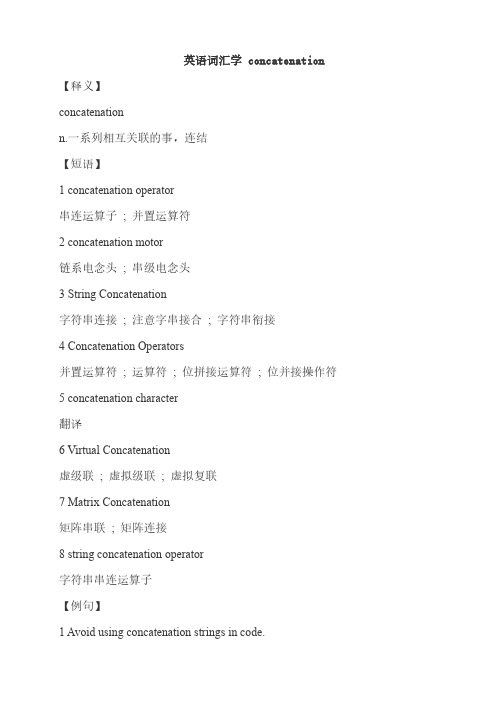
英语词汇学concatenation 【释义】concatenationn.一系列相互关联的事,连结【短语】1concatenation operator串连运算子;并置运算符2concatenation motor链系电念头;串级电念头3String Concatenation字符串连接;注意字串接合;字符串衔接4Concatenation Operators并置运算符;运算符;位拼接运算符;位并接操作符5concatenation character翻译6Virtual Concatenation虚级联;虚拟级联;虚拟复联7Matrix Concatenation矩阵串联;矩阵连接8string concatenation operator字符串串连运算子【例句】1Avoid using concatenation strings in code.避免在代码中使用连接字符串。
2Binding Parameters vs.String concatenation.绑定参数vs.字符串拼接。
3The simplest example is the concatenation of strings.最简单的示例是字符串串联。
4It returns a concatenation of the path formed using LHS and RHS.它将返回使用lhs和rhs形成的路径的串联值。
5For any given string,the correct value is the concatenation of.对于任意给定的字符串,正确值是由下列值并置而成的。
6The only difference is that concatenation is used instead of addition.惟一的差别是,这里使用的是并置(concatenation),而不是相加(addition)。
语言学专业词汇中英文对照版
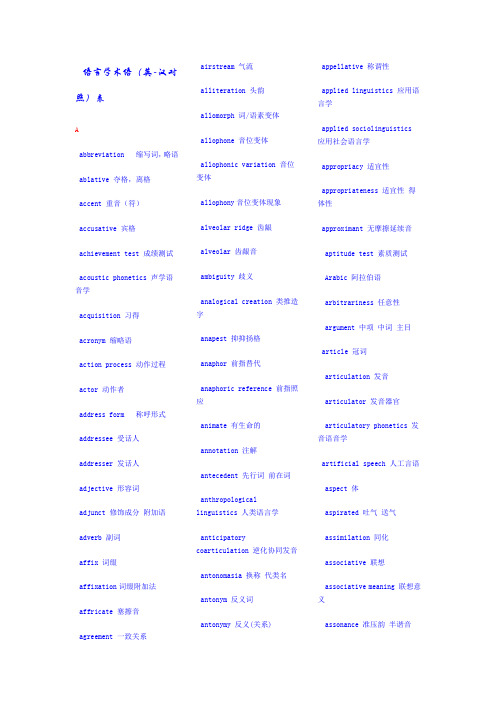
语言学术语(英-汉对照)表Aabbreviation 缩写词,略语ablative 夺格,离格accent 重音(符)accusative 宾格achievement test 成绩测试acoustic phonetics 声学语音学acquisition 习得acronym 缩略语action process 动作过程actor 动作者address form 称呼形式addressee 受话人addresser 发话人adjective 形容词adjunct 修饰成分附加语adverb 副词affix 词缀affixation词缀附加法affricate 塞擦音agreement 一致关系airstream 气流alliteration 头韵allomorph 词/语素变体allophone 音位变体allophonic variation 音位变体allophony音位变体现象alveolar ridge 齿龈alveolar 齿龈音ambiguity 歧义analogical creation 类推造字anapest 抑抑扬格anaphor 前指替代anaphoric reference 前指照应animate 有生命的annotation 注解antecedent 先行词前在词anthropologicallinguistics 人类语言学anticipatorycoarticulation 逆化协同发音antonomasia 换称代类名antonym 反义词antonymy 反义(关系)appellative 称谓性applied linguistics 应用语言学applied sociolinguistics应用社会语言学appropriacy 适宜性appropriateness 适宜性得体性approximant 无摩擦延续音aptitude test 素质测试Arabic 阿拉伯语arbitrariness 任意性argument 中项中词主目article 冠词articulation 发音articulator 发音器官articulatory phonetics 发音语音学artificial speech 人工言语aspect 体aspirated 吐气送气assimilation 同化associative 联想associative meaning 联想意义assonance 准压韵半谐音attributive 属性修饰语定语auditory phonetics 听觉语音学authentic input 真实投入authorial style 权威风格authoring program 编程autonomy 自主性auxiliary 助词auxiliary verb 助动词Bbabbling stage 婴儿语阶段back-formation 逆构词法base component 基础部分behavioural process 行为过程behaviourism 行为主义bilabial 双唇音bilabial nasal 双唇鼻音bilateral opposition 双边对立bilingualism 双语现象binary division 二分法binary feature 二分特征binary taxonomy 二分分类学binding 制约binding theory 制约论blade 舌叶舌面前部blank verse 无韵诗blending 混成法borrowing 借用借词bound morpheme 粘着语素bounding theory 管辖论bracketing 括号法brevity maxim 简洁准则bridging 架接broad transcription 宽式音标broadening 词义扩大Brown corpus 布朗语料库Ccalculability 可计算性calque 仿造仿造词语cancellability 可删除cardinal numeral 基数cardinal vowel 基本元音case 格case grammar格语法case theory格理论category 范畴categorical component 范畴成分causative 使役的使投动词center 中心词central determiner 中心限定词chain relation 链状关系chain system 链状系统choice 选择choice system 选择系统circumstance 环境因子class 词类class shift 词性变换clause 小句从句click 吸气音咂音clipping 截断法closed class 封闭类closed syllable 闭音节cluster 音丛coarticulation 协同发音coda 结尾音节符尾code 语码信码cognitive psychology 认知心理学cognitive system 认知系统coherence 相关关联cohension 衔接co-hyponym 同下义词colligation 类连结collocative meaning 搭配意义color word 色彩词color word system 色彩词系统command 指令common core 共核common noun 普通名词communication 交际communicative competence 交际能力communicative dynamism, CD 交际性动力communicative language teaching, CLT 交际语言教学法communicative Sentence Pattern, CSP 交际性句子模式communicative syllabus 交际教学大纲communicative test 交际性测试communicative-grammatical approach 交际-语法教学法compact disk 激光盘comparative degree 比较级competence 能力complement 补语complementary antonym 互补反义词complementary antonymy 互补反义关系complementary distribution互补分布complex predicate 复合谓语component 成分componential analysis 成分分析composite proposition 复合命题compositionality 复合性compound 复合词复合句comprehension 理解computation 计算computational linguistics 计算语言学computational system 计算系统computer-assisted learning,CAL 计算机辅助学习computer corpus 计算机语料库computer hardware 计算机硬件computer literacy 计算机操作能力computer networks 计算机网络computer system 计算机系统computer-assistedinstruction, CAI 计算机辅助教学computer-assistedlearning,CALL 计算机辅助语言学习conative 意动的concept 概念conceptual meaning 概念意义concord 一致(关系)concordance 共现关系concrete noun 具体名词concurrent 同时发生的conjugation 词形变化conjunct 连接副词conjunction 连接词conjunction buttressing 连接词支撑connotation 内涵consequent 跟随成分consonance 辅音韵consonant辅音constant opposition 不变对立constative 表述的constituent command 成分指令constituent proposition 成分命题constituent structure analysis 成分结构分析constituent 成分construct 编制construct validity 编制效度construction 构建constructivism 构建主义content analysis 内容分析content validity 内容效度content word 实义词context dependent 语境依赖的context of situation 情景语境context 语境contextual analyses 语境分析contextual meaning 语境意义contrastive analysis 对比分析control theory 控制理论controlled language 有控制的语言convention 常规规约conventional meaning 常规意义规约意义conventionality 常规性规约性conversational implicature会话含义conversational maxim 会话准则converse antonymy 相反反义现象conversion 变换cooperative principle, CP 合作原则coordinate construction 并列结构coordination 并列coreferential 互参的coronal 舌面前音corpus data 语料库语料corpus (pl corpora) 语料素材corpus linguistics 语料库语言学context 上下文countable 可数(名词)counterfactual proposition反事实命题couplet 对句对联creativity 创造性原创性Creole 克里澳尔语混和语cross-cultural communication跨文化交际cross-linguistic 跨语言的culturally-specific 文化特异的curriculum 教学大纲customizing 定制的Ddactyl 扬抑抑格Dani language 达尼语data retrieval, DR 资料检索database 数据库dative (case) 与格dative movement 与格移动declarative 陈述句decoding 解码deductive 演绎的deep structure 深层结构defeasibility 消除可行性definite 有定的degenerate data 无用的语料deixis 指称delicacy 精密阶denotation 外延指称dental 齿音dentalization 齿音化derivation 衍生derivational affix 衍生词汇derivational morphology 派生形态学descriptive adequacy 描写充分性descriptive linguistics 描写语言学design feature 结构特征determiner 限定词developing grammar 发展语法deviant 变体deviation 偏离变异devoicing 清音化diachronic linguistics 历时语言学diachronic 历时的diacritic 附加符号变音符diagnostic test 诊断性测试dialect 方言dialectology 方言学digitized sound 数字化语音dimetre 二音步诗行diphthong 二合元音双元音direct object 直接宾语direct speech, DS 直接言语direct thought, DT 直接思想directionality 方向性discourse 语篇话语discourse analysis 语篇分析话语分析discourse interpretation 语篇理解discrete 分离的离散的discrete-point grammar 离散语法discrete point test 分立性测试disjunction 分离关系displacement 移位dissimilation 异化(作用)distinctive feature 区别性特征distinguisher 辩义成分do-insertion rule do 添加规则domain 范围领域dorsal 舌背音舌中音dorsum 舌背(音)double comparative 双重比较drill-and-practice software操练软件D-structure D结构dual 双数dualistic view 二分观点duality 二重性Eearly Modern English 早期现代英语economy 经济性简洁性ejective 爆发音electronic mail 电子邮件Elizabethan English 伊利莎白时期英语ellipsis 省略(法)elliptical sentencestructure 省略句子结构embedded element 嵌入成分emic 位学的emotive 感情的empirical 经验主义的empirical data 经验主义的语料empirical validity 经验效度empiricism 经验主义empty category, EC 空范畴enabling skills 使成技能化encoding 编码end rhyme 末端韵endocentric construction 内向结构entailment 蕴涵entry condition 入列条件epenthesis 插音增音equipollent opposition 均等对立equivalence 相等equivalence reliability 相等信度error analysis 错误分析EST 科技英语ethnicity identity 民族认同ethnography of communication 交际民族学etic 非位的素的event process 事件过程example-based machine translation 基于例句的机器翻译exchange error 交换错误exchange sequence 交际序列exchange structure 交际结构exhaustive 穷尽的彻底的existent 存在物existential 存在句existential process 存在过程existential quantifier 存在数量词exocentric 外向的exocentric construction 外向结构experiential 经验的experiential function 经验功能experimentalpsycholinguistics 实验心理语言学explanatory adequacy 解释充分性explicit grammar instruction,EGI 明显的语法教学法expression minimization 表达最底程度expressive 表达的extended standard theory, EST扩展标准理论extensive 引申的扩展的extent-condition format 程度条件格式external evaluation 外部评估external qualifier 外部修饰语extrinsic sources of error 外在的错误来源eye movement 眼部移动Fface validity 卷面效度facilitation 便利促进Fasoldfeasibility 可行性feature 特征feedback 反馈felicity condition 适宜性条件恰当条件feminine 阴性fiction 小说figurative language 比喻性语言象征性语言figures of speech 修辞手段修辞格finite element 有定成分finite 有定的有限的finite state grammar 有限状态语法first-person narrator 第一人称叙述者Firthian phonology 弗斯音系学flap 闪音flexibility 灵活性变通性floppy disk 软盘focus 焦点中心folk etymology 俗词源学民间词源foregrounded features 突出特征foregrounding 突出前景话foreign language teaching 外语教学form 形式formal difference 形式差异formalization 形式化formation 形成formative 构形成分构词成分free form 自由形式free indirect speech, FIS 自由间接言语free indirect thought, FIT 自由间接思想free morpheme 自由语素free root morpheme 自由词根语素free variant 自由变体free verse 自由韵文French 法语frequency effect 频率效应fricative (摩)擦音friction 摩擦front 舌面前舌前的fully automatic high qualitytranslation, FAHQT 全自动高质量翻译function word 功能词function 功能functional grammar 功能语法functional linguistics 功能语言学functional sentenceperspective, FSP 功能句子观functions of language 语言功能fusion 溶合fuzzy 模糊的Ggender difference 性别差异general linguistics 普通语言学generalisation 概括generative grammar 生成语法generative semantics 生成语言学genitive 属格所有格genre 体裁语类German 德语given (information) 已给信息global task 整体任务glottal 喉音glottal stop 喉塞音goal 目标government theory 支配理论government 支配grammatical analysis 语法分析grammaticalfunction ; ;grammatical structure 语法结构gradable antonymy 分等级的反义关系gradual opposition 渐次对立grammatical category 语法范畴grammatical concept 语法概念grammatical description 语法描写grammatical form 语法形式grammatical marker 语法标记grammatical meaning 语法意义grammaticalorganization 语法组成grammatical pattern 语法类型grammatical process 语法过程grammatical rule 语法规则grammatical sentence pattern,GSP 语法句形grammatical structure 语法结构grammatical subject 语法主语grammatical system 语法系统grammatical word 语法词graphitic form 文字形式Gricean maxim Grice准则group 词组guttural 腭音Hhalf-rhyme 半韵hard palate 硬腭head 中心词中心成分headed construction 中心结构heptameter 七音步诗行hierarchical structure 等级结构hierarchical system 等级系统hierarchy 等级体系high 高(元音)historical linguistics 历史语言学holophrastic stage 单词句阶段homonym 同音/形异议词Hopi Hopi语horizontal relation 链状关系Horn scale 霍恩阶human cognitive system 人类认知系统human language 人类语言human speech 人类言语human translation 人译hypercorrection 矫枉过正hyponym 下义词hyponymy 下义关系hypothesis 假设hypothesis-deduction 假设-演绎Iiamb 抑扬格iambic pentameter 抑扬格五音步诗行IC analysis 直接成分分析法ICALL (intelligent CALL) 智能计算机辅助语言学习ideational (function) 概念功能identifying 认同的idiom 成语习语idiomatically-governed 习语支配的ill-formed sentences 不合适的句子illocutionary act 话中行为施为性行为illocutionary force 言外作用施为作用imaginative (function) 想象功能immediacy assumption 即时假定immediate constituent analysis 直接成分分析法imperative rule 祈使规则imperative 祈使语气命令的implicate 意含implication 蕴涵含义implication connective 蕴涵连接implicature 含义言外之意implied meaning 蕴涵意义implosive 内破裂音内爆音inanimate 无生命的inclusiveness relation 内包意义indefinite 不定的,无定的indicative 陈述式陈述语气indirect object 间接宾语indirct speech, IS 间接言语indirect thought, IT 间接思想Indo-European languages 印欧语言inference 推论推理inference drawing 推论inferential communication 推论交际infinitive不定式infix 中缀inflection 屈折(变化)inflectional affix 屈折词缀inflectional morphology 屈折形态学inflective endings 屈折结尾information retrieval 信息检索information structure 信息结构informative (function) 信息功能innateness 先天性innateness hypothesis (语法)天赋假设input 输入input hypothesis 语言输入说instrumental (function) 工具功能integrative test 综合性测试intensifier 强调成分intensive 强调的增强的interactional (function) 交互功能interdental 齿间音interface 界面interference 干扰interjection 感叹词interlanguage 中介语interlingua 国际语interlingual approach 语际法interlocutor 会话者internal evaluation 内部评估internal structure 内部结构international phoneticalphabet, IPA 国际音标internet 互联网interpersonal 人际的interpersonal function 人际功能interpretation 解释interrogative sentence 疑问句intonation 语调intra-linguistic relation 语言内关系intransitive 不及物的intrinsic sources of error 错误的内源invariable word 不变词invention 新创词语inversion 倒置,倒装IPA chart 国际音标图IPS symbol 国际音标符号irony 讽刺反话isolated opposition 孤立对立Italian 意大利语JJapanese 日语jargon 黑话行语Jesperson,OttoJohnson & JohnsonJohnsonJones,DanielKkernel sentence 核心句keyword关键词knowledge 知识known information 已知信息KrashenKruszewski, MikolajKuno, SusumoLlabel 标示标记labial 唇音labiodental 唇齿音language 语言language acquisition device, LAD 语言习得机制language attitude 语言态度language choice 语言选择language comprehension 语言理解language data 语言素材language learning 语言学习language maintenance 语言维护language processing 语言处理language structure 语言结构language system 语言系统language teaching 语言教学language universal 语言普遍性language use 语言使用langue 语言(系统)larynx 喉头lateral 边音旁流音Latin 拉丁语Latin grammar 拉丁语法lax vowel 松元音length 长度音长letter 字母level 层,级,平面Levinson, Stephenlexeme 词位词素lexical ambiguity 词汇歧义lexical change 词汇变化lexical level 词汇层lexical meaning 词汇意义lexical morphology 词汇形态学lexical studies 词汇研究lexical word 词汇词lexicogrammar 词汇语法lexicon 词汇词典lexis 词liaison 连音连续limerick 打油诗line 诗行linear phonology 线性音系学linear structure 线形结构linguistic university 语言普遍性linguistic behaviour 语言行为linguistic behaviourpotential 语言行为潜势linguistic competence 语言能力linguistic context 语言语境上下文linguistic data 语言素材linguistic description 语言描写linguistic determinism 语言决定论linguistic facts 语言事实linguistic relativity 语言相对性linguistic sexism 语言性别歧视linguistic structure 语言结构linguistic theory 语言理论linguistic unit 语言单位linguistic universal 语言普遍性linguistic variation 语言变异linguistics 语言学lip rounding 圆唇化literal language 本义语言literary stylistics 文学文体学loan translation 翻译借词loanblend 混合借词loanshift 转移借词loanword 借词local area networks, LAN 局域网locutionary act 发话行为,表述性言语行为logical component 逻辑成分logical connective 逻辑连词logical form component 逻辑式成分logical form representation逻辑式表达logical formula 逻辑公式logical function 逻辑功能logical semantics 逻辑语义学logical structure 逻辑结构logical subject 逻辑主语logophoricity 词照应London School 伦敦学派long vowed 长元音loss of sound 语音脱落loudness 响度Mmachine translation 机器翻译macrolinguistics 宏观语言学macroproposition 宏观命题macrostructure 宏观结构main clause 主句Malinowski,Bronislawman-machine symbiosis 人机共生manner maxim 方式准则manner of articulation 发音方式marked 标记的masculine 阳性matalinguistic 元语言学的material (process) 物质过程mathematical principles 数学原理maxim 准则maximal onset principle 最大节首辅音原则meaning potential 意义潜势meaning shift 转移meaning 意义mental (processs) 思维过程心理过程mentalism 心灵主义message 信息metafunction 元功能metalinguistic 元语言的metaphor 隐喻metathesis 换位(作用)metonymy 换喻转喻metre 韵律metrical patterning 韵律格式microcomputer 微机microprocessor 微处理器mid 中(元音)mind 思维minimal attachment theory 最少接触理论minimal pair 最小对立体minimalist programminimum free form 最小自由形式mirror maxim 镜像准则mistake 错误modal subject 语气主语modal verb 情态动词modality 情态modern French 现代法语modification 修饰modifier 修饰语monomorphemic 单语素的monophonemic 单音位的monophthong 单元音monosyllabic 单音节的Motague grammar 蒙太古语法mood 语气morph 形素词素形式morpheme 语素词素形素morpheme-exchange error 词素交错误morphemic shape 词素形状morphemic structure 词素结构morphemic transcription 词素标音morphological change 形态变化morphological rule 形态规则morphology 形态学morpho-phonemic component 形态音位成分morphophonemics 形态音位学morphophonology 形态音系学morpho-syntactical change 形态句法变化mother tongue 母语本族语motivation 动因动机move (移动)MT 机器翻译MT quality 机译质量multilateral opposition 多边对立multi-level phonology 多层次音系学multilingualism 多语制多语现象N narratee 被叙述者narrator 叙述者narrator’s representationof speech acts, NRSA 言语行为的叙述者表达narrator’s representationof speech, NRS 言语的叙述者表达narrator’s representationof thought acts, NRTA 思维行为的叙述者表达narrator’s representationof thought, NRT 思维的叙述者表达narrow transcription 窄式音标narrowing 狭窄化nasal 鼻音nasal cavity 鼻腔nasal sound 鼻音nasal stop 鼻塞音nasal tract 鼻道nasality 鼻音性nasalization 鼻音化Nash, Walternative speaker 操本族语者natural language 自然语言naturalistic data 自然语料near-adult grammar 近成人语法negation 否定否定结构negative 否定的negative interference 负面干扰negative marker 否定标记negative transfer 负转移neogrammarian 新语法学家network 网络network computer 网络计算机neutralizable opposition 可中立对立new information 新信息new stylistics 新文体学node 节nominal group 名词词组nominalization 名词化nominative 主格non-authentic input 非真实语料的输入non-contrastive analysis 非对比性分析non-conventionality 非规约性non-detachability非可分离性non-linear phonology 非线性音系学non-linguistic entity 非语言实体non-pulmonic sound 非肺闭塞音non-reciprocal discourse 非交替性语篇non-reflexive pronoun 非反身代词nonsense word stage 无意义词语阶段nonverbal cues 非言语提示norm 规范notation system 标写系统notion 意念notional-functional syllabus意念功能教学大纲noun phrase 名词短语noun 名词number system 数字系统number 数字Oobject 宾语object-deletion 宾语省略objective case 宾格objectivity 客观性obligatory 强制性observational adequacy 观察充分性abstruction 阻塞OCR scanner 光学字符阅读器扫描仪octametre 八音步诗行Old English 古英语one-place predicate 一位谓语on-line translation 在线翻译onomatopoeia 拟声词onset 节首辅音open class 开放类open syllable 开音节operational system 操作系统operative 可操作性operator 操作词oppositeness relation 对立关系opposition 对立optimal relevance 最适宜关联option 选择optional 可选择的oral cavity 口腔oral stop 口阻塞音ordinal numeral 序数词origin of language 语言起源orthography 正字法ostensive communication 直示交际output 产出overgeneralization 过分法则化Ppalatal 腭音舌面中音palatal-alveolar 腭齿龈音palatalization (硬)腭化paradigm 聚合体paradigmatic relation 聚合关系paraphrase 释义意译parole 言语part of speech 词类participant 参与者particle 小品词语助词particular grammar 特定语的语法partitive 部分的部分格passive transformation 被动转换passive (voice) 被动语态pattern drill technique 句型操练法pattern 模式patterning 制定模式pause 停顿peak (节)峰perceptual span 感知时距perfectionism 完善主义perfective 完成体performance test 语言运用测试performance 语言运用performative (verb) 行事性动词perlocutionary act 话后行为perseverative coarticulation重复性协同发音person 人称personal (function) 自指性功能pharyngeal 咽头音喉音pharynx 喉头phatic (communion) 寒暄交谈交感性谈话phone 音素音子phonematic unit 音声单位phoneme 音位phonetic alphabet 音标phonetic form component 语音形式部分phonetic similarity 语音相似性phonetic symbol 语音符号phonetic transcription 标音(法)phonetics 语音学phonological analysis 音位分析phonological component 音位部分phonological level 音系层phonological process 音位过程phonological representation 音位表达phonological rule 音位规则phonological structure 音位结构phonological system 音位系统phonological variant 音位变体phonology 音系学phrasal verb 短语动词phrase 短语phrase structure 短语结构phrase structure grammar 短语结构语法phrase structure rule, PSrule 短语结构规则pidgin 皮软语洋泾滨语不纯正外语Pitch 音高声调高低place of articulation 发音部位play 剧本plosion 爆破plosive 爆破音爆发音plural 复数pluralism 多元主义plurality 复数形式poetic (function) 诗学功能poetry 诗歌polymorphemic (word) 多语素词polysyllabic 多音节(词)polysystemic analysis 多系统分析Portugese 葡萄牙语positive transfer 正移转possessive 所有的属有的possible grammar 可能语言的语法postalveolar 后齿龈音post-Bloomfieldianlinguistics 后布龙菲尔德语言学postdeterminer 后限定词post-structuralist view 后结构主义观点pragmatic inference 语用推论pragmatic roles 语用角色pragmatics 语用学Prague School 布拉格学派predeterminer 前限定词predicate calculus 谓语演算predicate logic 谓语逻辑predicate 谓语predicator 谓语(动)词predictive validity 预测效度pre-editing 预先编辑译前加工prefix 前缀pre-modified input 预修正的输入premodifier 前修饰语preposition 介词prepositional calculus 介词演算prepositional logic 介词逻辑prepositional opposition 介词对立prepositional phrase 介词短语prescriptive 规定式presupposition 前提预设primary cardinal vowel 主要基本元音primary stress 主重音第一重音principle of informativeness信息性原则principle of least effort 最省力原则principle of quantity 数量原则privative opposition 表非对立表缺对立process 过程production error 产生性错误productivity 多产性proficiency test 水平测试pro-form 代词形式替代形式programming language 编程语言progressive 进行体progressive assimilation 顺同化projection rule 投射规则pronominal 代词pronoun 代词pronunciation 发音pronunciation dictionary 发音词典pronunciation 发音proportional opposition 部分对立proposition 命题prose style 散文风格prosodic analysis 节律分析超音质分析psycholinguistics 心理语言学psycholinguistic-sociolinguistic approach 心理-社会语言学方法psychological reality 心理现实psychological subject 心理主语psychology of language 语言心理学psychometric-structuralistapproach 心理测定-结构主义法pulmonic sound 肺闭塞音Putonghua 普通话QQ-based implicature 基于质量的含义Q-principle 质量原则quality 质量quality maxim 质量准则quantifier 数量词quantitative analysis 定量分析quantitative paradigm 数量变化表quantity maxim 数量准则quatrain 四行诗Rrange 范围rank 级rationalism 理性主义raw data 原始素材R-based implicature 基于关联的涵义reader 读者reading comprehension 阅读理解realisation 体现recall 回忆received pronunciation, RP标准发音receiver 受话者信息接受者recency effect 近期效应recognition 识别recursion 可溯recursive 可溯的还原的recursiveness 递归性reference 所指参照referential meaning 所指意义referential theory 所指理论referential 所指的reflected meaning 反映意义reflexive (form) 反身形式regional dialect 地域方言register 语域regressive assimilation 逆同化regulatory (function) 控制性语言功能relation maxim 关系准则relational opposite 关系对立relational process 关系过程relative clause 关系分句关系从句relative pronoun 关系代词relative uninterruptibility相对的非间断性relevance theory 关联理论reliability 信度repetition 重复representational system 表达系统representational 表达实体residue 剩余成分restricted language 限制性语言retrieval process 检索过程retrieval system 检索系统retroflex sound 卷舌音reverse rhyme 反陨revised extended standard theory, REST 修正扩展标准理论rewriting rules 重写规则rheme 述位rhetorical skill 修辞技能rhyme 韵韵角压韵rhythm 韵律节奏Roman alphabet letter 罗马字母root 词根root morpheme 词根语素round vowel 圆元音R-principle 关联原则rule system 规则系统rule-based approaches 基于规则的方法rules of language 语言规则Ssameness relation 相同关系Sanskrit 梵文Sapir-Whorf Hypothesis 萨丕尔-沃夫假设Saussure 索绪尔scale of delicacy 精密阶schema 图式scheme-oriented language 面向图式的语言second language acquisition第二语言习得secondary cardinal vowel 次要基本元音secondary stress 次重音segment 音段selection restriction 选择限制selectional rules 选择规则self-reflexive 自反身semantic association network语义关联网络semantic change 语义变化semantic component 语义部分semantic feature 特征semantic interpretation 语义解释semantic interpretativerules 语义解释规则semantic process 语义过程semantic representation 语义表达semantic sentence pattern,SSP 语义句型semantic triangle 语义三角semantics 语义学semi-consonant 半辅音semiotic system 符号系统semiotics 符号学semi-vowel 半元音sense relation 意义关系sense 意义sentence 句子sentence fragments 句子成分sentence meaning 句义sentence memory 句子记忆sentence stress 句重音sentence structure 句子结构sentential calculus 句子演算setting 场景sibilant 咝擦音sign 符号signified 所指受指signifier 能指施指simile 明喻simultaneity 同时性singular 单数situational context 情景语境situational level 情景层situational syllabus 情景教学大纲situational variation 情景变异slot 空缺social role 社会角色social semiotic 社会符号学socio-cultural role 社会文化角色sociolinguistic study of language 语言的社会语言学研究sociolinguistic study ofsociety 社会的社会语言学研究sociolinguistics 社会语言学sociological approach 社会学方法soft palate 软腭solidarity 团结sonnet 十四行诗sonorant 响音sonority scale 响音阶sound 语音sound image 语音图像sound pattern 语音模式sound segment 音段sound system 语音系统sound wave 音波speaker’s meaning 说话者意义speech 言语speech act theory 言语行为理论speech community 言语社团speech comprehension 言语理解speech event 言语事件speech function 言语功能speech mode 言语方式speech organ 言语器官speech perception 言语感知speech presentation言语表达speech production ; 言语产生speech research言语研究speech role言语角色speech sound 语音speech synthesis 言语合成spelling 拼写,拼法split infinitives 分裂的不定式spoken corpus 口语语料库spoken language translation口语翻译spondee 扬扬格spoonerism 首音互换斯本内现象spread 展元音S-structure 表层结构stability 稳定性stability reliability 稳定性效度Standard English 标准英语standard theory 标准理论standardization 标准化statistical analysis 统计分析status 地位stem 词干stimulus 刺激stimulus-response 刺激反应stop 闭塞音stored knowledge 储存知识strategic knowledge 学习策略知识stratification 层stream of consciousness 意识流stress pattern 重音模式stress 重音structural analysis 结构分析structural (structuralist) grammar 结构语法structural syllabus 结构教学大纲structural test 结构测试structuralism 结构主义structuralist linguistics 结构主义语言学structuralist view 结构主义观点style 文体风格stylistic analysis 文体分析stylistics 文体学subcategorize 次范畴subject 主语subject-deletion 主语省略subjective test 主观性测试subjectivity 主观性subjunctive mood 虚拟语气subordinate construction 从属结构subordination 从属substitutability 替代性substitution 替换suffix 后缀superlative degree 最高级superordinate 上坐标词suprasegmental feature超语段特征surface form 表层形式surface representation 表层表达surface structure 表层结构syllabic structure 音节结构syllabification 音节划节syllable 音节syllabus design 教学大纲设计syllabus 教学大纲syllogism 三段论法symbol 符号synchronic (linguistics) 共时(语言学)synonym 同义词synonymous 同义的synonymy 同义现象syntactic component 句法部分syntactic features 句法特征syntactic function 句法功能syntactic marker 句法标记syntactic process 句法过程syntactic restriction 句法限制syntactic structure 句法结构syntactical change 变化syntagmatic relation 组合关系syntax 句法system network 系统网络system of signs 符号系统。
【VIP专享】英语词汇学引论 术语翻译

Abberbation 缩写;缩略Ablative case 夺格(即第五个或工具格)Absolute synonym 绝对同义词Accusative case 直接宾格Acronym 首字母缩略词Aderbial clause of concession 让步状语从句Affix 词缀Affixation 词缀法Alien 外国词Alliteration 头韵Alphabetical order 字母表顺序Amelioration 进化Analogy 类比Analytic language 分析性语言Anthropomorphic 拟人化的Antonym 反义词Antonymy 翻译关系Approach to 方法Archaism 古词Arbitrary 任意的Argot 黑话Autosemantic 词本身有独立意义的Base 词基Back-formation 逆成法Bilingual 双语的Blend 拼缀词Blending 拼缀法Borrowed word 借词Borrowing 借词Bound morpheme 粘着形位Briton 布立吞人Capitalization 大写Case 格Classical element 古典成分Clipping 缩短法Collocability 词的搭配能力Collocation 词的搭配Colloquialism 口语词Colloquial style 口语语体Combining form 构词成分Complementaries 互补性反义词Complex word 复合词Compound 合成词Compound word 合成词Compounding 合成法Concatenation 连锁型语义演变过程Conjugation 动词变位Connotative meaning 内含意义Context 语境Contraries 相对性反义词Conventional 约定俗成的Converging sound-development 语音发展的一致性Conversion 转类法Conversives 换位性反义词Cosmopolitan character 国际性Dative case 与格(第三格)De-adjectival 由形容词转变而来的Declension 名词、形容词等的变格Degradation of meaning 意义的降格Denizen 外来词Denominal nouns :abstract 纯名词表示抽象意义Denominal nouns :concrete 纯名词表示具体意义Denotative meaning 外延意义Derivative antonym 派生反义词Deterioration 退化Deverbal noun 由动词派生的名词Diachronic approach 历时分析法Diachronic dictionary 历史语言学词典Diachrony 历时分析Dialect 方言Double genitive case 双生格Doublets 两词一组的同义词Elevation of meaning 意义的升格Encyclopaedic dictionary 百科全书词典Entry 词条Etymology 词源学Euphemism 委婉语Euphony 语音的和谐悦耳Existing word 现行的词Exocentric word 离心结构合成词Extension of meaning 意义的扩大Figure of speech 修饰手段Figurative use 比喻用法Foreign element 外来语成分Formal word 书面词Form-word 虚词Free from 自由形式Free morpheme 自由形位Free phrase 自由词组French element 法语成分Full conversion 完全转类法Full word 实词Functional word 虚词Generalization 一般化Genitive case 生格(第二格)General dictionary 一般性词典Glossary 难词Headword 词目Homoform 同语法形式异义词Homograph 同形异音异义词Homonym 同音异义词;同形异义词;同音同形异义词Homonymy 同音、同形、同音同形异义词的研究Homophone 同音异形异义词Hybrid 混合词Hyponym 下意词Hyponymy 上下意关系Idiom 习语Idiomatic phrase 惯用语词组Imperative sentence 祈使句Indo-European family 印欧语系Inflected language 曲折性语言Informal word 口语词Jargon 行话Latin element 拉丁语成分Leveled inflections 曲折变化弱化Linguistic context 语言语境Literal use 字面用法Loan-word借词Locative case 位置格Locative prefix 表示地点的前缀Lost inflections 曲折变化消失Main stress 主重音Medium-sized dictionary 中型词典Metaphor隐喻Middle English 中古英语Miscellaneous prefix 混合型前缀Monosemy 一词单意Morpheme 形位Morphology 词法Motivation 理据Multilingual 用多种语言表达的;多语的Narrowing of meaning 意义的缩小Native element 本族语成分Native word 本族语词Negative prefix 表示否定的前缀Neo-classical 新古典主义的Neologism 新词New word 新词Nominative case 主格Nonce word 临时造的词Non-linguistic context 非语言语境Notional word 实词Number prefix 表示数目的前缀Obsolete word 费词Official language 官方语言Old English 古英语Onomatopoeia 象声词Open 分开写的Orthographic criterion 正字法标准Part of the speech 词类Partial conversion 部分转类法Pejorative prefix 表示贬义的前缀Pahatic communion 交际性谈话Phonetics 语音学Phonology 音位学Phraseological idiom 熟语Physiology 生理学Pocket dictionary 小型词典Polarity 对立性Polysemic character 一词多义性Polysemy 一词多义Popular 通俗的Possessive case 所有格Preciseness 精确性Prefix 前缀Prefixation 前缀法Private prefix 表示反义的前缀radiation 放射型的语义演变过程reduplicative compound 或者reduplicative(s )重叠合成词reference 语词所指涵义referent 语词所指事物relative synonym 相对同义词repetition 重复representative work 代表作reversative prefix表示反义的前缀rhyme 韵脚richness丰富性root 词根root antonym词根反义词Scandinavian element 斯堪的纳维亚语成分Secondary stress次重音Semantic borrowing(s)义借词Semantics语义学Semiotic triangle三角关系符号学理论Sense-shift语义转换Shade of meaning意义的(细微)差别Shortening缩短法(the)sign theory of Saussure索绪尔符号理论Signified(借助符号进行交际的)事物的概念或涵义Signifier代表事物的概念或涵义符号Simile明喻Slang俚语solid(合成词中两个词)连起来写的special dictionary专门性词典specialization 特殊化Spelling拼写Stem词干Stylistics文体学Suffix后缀Suffixation后缀法(the)superordinate (term)上义词Survival(s)(vestiges)保留下来的词Sychronic approach共时分析法Sychronic dictionary共时语言学词典Synchrony共时分析Synesthetic(产生)联觉的Synecdoche提喻法Synonym同义词Synonymy 同义关系Synsemantic 与其他词连用时才有意义的Teutonic language条顿(日耳曼)语言The Angles,Saxons and Jutes盎格鲁人撒克逊人,朱特人The Norman conquest 诺曼征服英国Translation-loans译借词Triplets三词一组的同义词Unabridged dictionary 大型(无任何删节的)词典Variety (语言的)变体Word-class 词类Word -formation word-building 构词法Word-forming ability 构词能力Word-stock词汇Working language 工作语言。
自考英语词汇学学术语单词对照表

∙aallomorph['æləumɔ:f]基本释义同近义词∙n. 同质异晶;同质异形体ambiguity[,æmbi'ɡju:iti]基本释义词组短语同近义词∙n. 含糊;不明确;暧昧;模棱两可的amelioration[ə,mi:ljə'reiʃən]基本释义同近义词∙n. 改进,改善analytic[,ænə'litik,-kəl]基本释义词组短语antithesis[æn'tiθisis]基本释义同近义词∙n. 对立面;对照;对仗∙adj. 分析的;解析的;善于分析的antonymy[æn'tɔnimi]基本释义∙n. 反义词组;反义现象appreciative[ə'pri:ʃiətiv]基本释义同近义词∙adj. 感激的;赏识的;有欣赏力的;承认有价值的archaic[ɑ:'keiik]基本释义同近义词∙adj. 古代的;陈旧的;古体的;古色古香的archaism['ɑ:keiizəm, -ki-]基本释义n. 古语;拟古主义;古体argot['ɑ:ɡəu, 'ɑ:ɡət]基本释义同近义词∙n. 隐语;暗语;暗号;俚语;黑话armenian[ɑ:'mi:njən]基本释义∙n. 亚美尼亚人;亚美尼亚语∙adj. 亚美尼亚的;亚美尼亚人的clipping ['klipiŋ]基本释义词组短语同近义词∙n. 剪裁,剪断;剪报,剪辑;剪下物,剪下的东西∙adj. 头等的,第一流的;极好的,恰好的balto-slavic['bɔ:ltən'slɑ:vik]基本释义∙n. 印欧语中的波罗的海语系bound [baund]英汉翻译∙adj. 受约束的;装有封面的;有义务的∙vt. 束缚;使跳跃∙n. 跳跃;范围∙vi. 弹起;限制catchphrase['kætʃfreiz]基本释义同近义词∙n. 标语,警句Celtic ['keltik;'sel-]基本释义∙adj. 凯尔特人的;凯尔特语的∙n. 凯尔特语(等于Keltic)collocation[,kɔləu'keiʃən]英汉翻译∙n. 搭配;配置;排列colloquialism[kə'ləukwiəlizəm]基本释义同近义词∙n. 白话,口语;口语体;方言用语concatenation[kɔn,kæti'neiʃən]基本释义同近义词∙n. 串联,连结connotation[,kɔnəu'teiʃən]基本释义同近义词∙n. 内涵;含蓄;暗示,隐含意义;储蓄的东西(词、语等)constituent[kən'stitjuənt]基本释义词组短语同近义词∙n. 成分;选民;委托人∙adj. 构成的;选举的consultative[kən'sʌltətiv]基本释义词组短语同近义词∙adj. 咨询的couplet ['kʌplit]基本释义同近义词∙n. 对联;对句degradation[,deɡrə'deiʃən]基本释义词组短语同近义词∙n. 退化;降格,降级;堕落deletion[di'li:ʃən]基本释义词组短语同近义词∙n. 删除;[遗]缺失;删除部分denizen['denizən]基本释义同近义词∙vt. 给…居住权;移植∙n. 居民;外来语;外籍居民denominal[di'nɔminəl]基本释义∙adj. 来自名词(形容词)的∙n. 来自名词(形容词)的词denotation[,di:nəu'teiʃən]基本释义同近义词∙n. 符号;表示;意义;指示derivation[,deri'veiʃən]∙基本释义词组短语同近义词n. 引出;来历;词源derogatory[di'rɔɡətəri]基本释义词组短语同近义词adj. 贬损的diachronic[,daiə'krɔnik,-kəl]基本释义∙adj. 探求现象变化的;历经时间长河duplication[,dju:pli'keiʃən]英汉翻译∙n. 复制;副本;成倍equivalent[i'kwivələnt]英汉翻译∙adj. 等价的,相等的;同意义的∙n. 等价物,相等物etymology[,eti'mɔlədʒi]基本释义∙n. 语源,[语] 语源学[ 复数etymologies ]euphemism['ju:fimizəm]基本释义同近义词∙n. 委婉语;委婉说法morpheme['mɔ:fi:m]基本释义∙n. [语] 词素;形态素generalisation[,dʒenərəlai'zeiʃən, -li'z-]基本释义同近义词∙n. (英)一般化;归纳;普遍原理(等于generalization)grammatical[ɡrə'mætikəl]基本释义词组短语同近义词∙adj. 文法的;符合语法规则的graphology[ɡræ'fɔlədʒi]基本释义∙n. 笔迹学;笔迹相法;图表法hellenic[he'lenik, -'li:-]基本释义同近义词∙adj. 希腊的;希腊人的;希腊语的heterogeneous[,hetərəu'dʒi:njəs]基本释义词组短语同近义词∙adj. [化学]多相的;异种的;[化学] 不均匀的;由不同成分形成的homograph['hɔməuɡrɑ:f, -ɡræf]基本释义∙n. 同形异义字homonym['hɔməunim]基本释义∙n. 同音异义词;同形异义词;同形同音异义词;同名异物homonymy[hɔ'mɔnimi]基本释义∙n. 同音异义homophone['hɔməufəun]基本释义∙n. 同音异形异义字idiom ['idiəm]基本释义同近义词∙n. 成语,习语;土话idiomatic[,idiə'mætik]基本释义词组短语∙adj. 惯用的;符合语言习惯的;通顺的Iranian[i'reinjən]基本释义∙adj. 伊朗的;伊朗人的;伊朗语的∙n. 伊朗人;伊朗语initialism[i'niʃəlizəm]基本释义同近义词∙n. 首字母缩略词intimate['intimət]基本释义词组短语同近义词∙adj. 亲密的;私人的;精通的;有性关系的∙n. 知己;至交∙vt. 暗示;通知;宣布juxtaposition[,dʒʌkstəpə'ziʃən]基本释义同近义词∙n. 并置,并列;毗邻lexical['leksikəl]基本释义词组短语同近义词∙adj. 词汇的;[语] 词典的;词典编纂的lexicography[,leksi'kɔɡrəfi]基本释义∙n. 词典编纂lexicology[,leksi'kɔlədʒi]基本释义∙n. 词汇学;词典学lexis ['leksis]基本释义同近义词∙n. 词汇;词语literary ['litərəri]基本释义词组短语同近义词∙adj. 文学的;书面的;精通文学的loan [ləun]基本释义词组短语同近义词∙n. 贷款;借款∙vi. 借出∙vt. 借;借给metaphor['metəfə]基本释义同近义词∙n. 暗喻,隐喻;比喻说法metonymy[mi'tɔnimi, mə-]基本释义∙n. 转喻monolingual[,mɔnəu'liŋɡwəl]基本释义∙adj. 单语的;仅用一种语言的;仅懂一种语言的∙n. 只用一种语言的人monosomic[,mɔnəu'səumik]基本释义同近义词∙adj. 单(染色)体的morphology[mɔ:'fɔlədʒi]基本释义词组短语同近义词∙n. 形态学,形态论;[语] 词法,[语]词态学neoclassical[,ni:əu'klæsikəl]基本释义词组短语∙adj. 新古典主义的neologism[ni:'ɔlədʒizəm,ni-]基本释义同近义词∙n. 新词;新义;新词的使用notional['nəuʃənəl]基本释义同近义词∙adj. 概念性的;想像的;抽象的;不切实际的obsolete['ɔbsəli:t, ,ɔbsə'li:t]基本释义词组短语同近义词∙adj. 废弃的;老式的∙n. 废词;陈腐的人vt. 淘汰;废弃onomatopoeic[,ɔnə,mætə'pi:k]英汉翻译∙adj. 拟声的;声喻的orthographic[,ɔ:θəu'ɡræfik]基本释义词组短语同近义词∙adj. 正字法的;拼字正确的;直角的pejoration[,pi:dʒə'reiʃən]基本释义同近义词∙n. 恶化;堕落;语义的转贬polysemic网络释义多义性polysemous[,pɔli'si:məs]基本释义∙adj. 一词多义的;有多种解释的reduplication[ri,dju:pli'keiʃən]基本释义同近义词∙n. 加倍;复本;复制器;重复referential[,refə'renʃəl]基本释义词组短语同近义词∙adj. 指示的;用作参考的Scandinavian[,skændi'neiviən; -vjən]基本释义∙n. 斯堪的纳维亚人;斯堪的纳维亚语;北欧日耳曼语系∙adj. 斯堪的纳维亚的;斯堪的纳维亚人的;斯堪的纳维亚语的;北欧日耳曼语系的semantic[si'mæntik]基本释义词组短语∙adj. 语义的;语义学的(等于semanticalsubordinate[sə'bɔ:dinət,-neit,sə'bɔ:dineit]基本释义词组短语同近义词∙n. 下属,下级;部属,属下∙adj. 从属的;次要的∙vt. 使……居下位;使……服从[ 过去式subordinated过去分词subordinated 现在分词subordinatingsuperordinate[,sju:pə'rɔ:dinət]基本释义同近义词∙adj. 上级的,地位高的;高级的[ 过去式superordinated 过去分词superordinated现在分词superordinating ]synthetic[sin'θetik]基本释义词组短语同近义词∙adj. 综合的;合成的,人造的∙n. 合成物triplet ['triplit]基本释义词组短语同近义词∙n. 三个一组;三连音符;三元组中的一个;三胞胎之一verbal ['və:bəl]基本释义词组短语同近义词∙adj. 口头的;言语的;动词的;照字面的∙n. 动词的非谓语形式unabridged[,ʌnə'bridʒd]基本释义同近义词∙adj. 完整的;未经删节的;足本的。
完全版英语词汇学名词解释
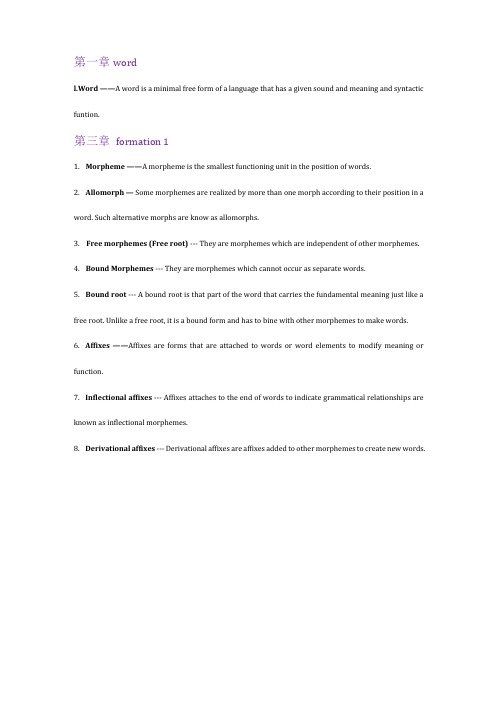
第一章wordl.Word ——A word is a minimal free form of a language that has a given sound and meaning and syntactic funtion.第三章formation 11.Morpheme ——A morpheme is the smallest functioning unit in the position of words.2.Allomorph —Some morphemes are realized by more than one morph according to their position in a word. Such alternative morphs are know as allomorphs.3.Free morphemes (Free root) --- They are morphemes which are independent of other morphemes.4.Bound Morphemes --- They are morphemes which cannot occur as separate words.5.Bound root --- A bound root is that part of the word that carries the fundamental meaning just like a free root. Unlike a free root, it is a bound form and has to bine with other morphemes to make words.6.Affixes ——Affixes are forms that are attached to words or word elements to modify meaning or function.7.Inflectional affixes --- Affixes attaches to the end of words to indicate grammatical relationships are known as inflectional morphemes.8.Derivational affixes --- Derivational affixes are affixes added to other morphemes to create new words.9.Prefixes ——Prefixes are affixes that e before the word.10.Suffixes --- suffixes are affixes that e after the word.11.Roo t ——A root is the basic form of a word which cannot be further analysed without total loss of identity.12.Stem ——a stem can be defined as a form to which affixes of any kind can be added.第四章formation 21, Affixation -affixation is generally defined as theformation of words by adding word-forming or derivational affixes to stems.2.Prefixation ——is the formation of new words by adding prefixes to stems.Suffixation--- is the formation of new words by adding suffixes to stems.3.pounding (positon) -- is the formation of new words by joining two or more stems.4.Conversion-- is the formation of new words by converting words of one class to another class.5.Blending-- is the formation of new words by bined by parts of two words or a word plus a plus a part of another word.6.Clipping- is the formation of new words by shortening a longer word by cutting a part off the original and using what remain instead.7.Acronymy-- is the process of forming new words by joining the initial letters of names of social and political organizations or special noun phrases and technical terms.8.Back-formation -- is a process of word-formation by which a word is created by the deletion of a supposed affix. E.g. editor entered the language before edit. 第五章meaning1.Reference --- the relationship between language and the world.2.Concept ——which beyond language, is the result of human cognition, reflecting theobjective world in the human mind.3.Sense- denotes the relationship inside the language.4. Motivation - -accounts for the connection between the linguistic symbol and its meaning.5. Onomatopoeic Motivation - -These words were created by imitating the natural sounds or noises.6. Morphological Motivation--pounds and derived words are multi-morphemic words and the meaning of many are the sum total of the morphemes bined.7. Semantic Motivation - -refers to the mental associations suggested by the conceptual meaning of a word. 8. Etymological Motivation-- The history of the word explains the meaning of the word9.Grammatical meaning - refer to that part of the meaning of the word which i ndicates grammatical concept or relationships.10.Lexical meaning--is constant in all the words within or without context relat ed to the notion thatthe word conveys.11.Conceptual meaning (denotative meaning) - the meaning given in the di ctionary and forms the core of word-meaning12.Associative meaning - the secondary meaning supplemented to the concep tual meaning. It is open-ended and indeterminate13.Connotative meaning ---the overtones or association suggested by the con ceptual meaning14.Stylistic meaning - stylistic features make the words appropriate for different contexts.15. Affective meaning - the speaker’s attitude towards the person or thing in q uestion.第六章Sense Relations and semantic Field23.Abbreviation includes four types : I. Clipped words II. Initialisms III. Acronyms I. II. Initialisms--are words formed from the initial letters of words and pronounced as letters. E.g. IMF/ai emef/=International Monetary Fund. III.IV. Blends--are words that are bined by parts of other word24.Opaque Words--Words that are formed by one content morpheme only and cannot be analysedinto parts are called opaque words, such as axe, glove.25.Transparent Words --Words that consist of more than one morphemes and can be segmented into parts are called transparent words: workable(work+able), door-man(door+man).26.Morphs--Morphemes are abstract units, which are realized in speech by discrete units known as morphs. They are actual spoken, minimal carriers of meaning.27.Allomorps--Some morphemes are realized by more than one morph according to their position in a word. Such alternative morphs are known as allomorphs. For instance, the morpheme of plurality {-s} hasa number of allomorphs in different sound context, e.g. in cats /s/, in bags /z/, in match /iz/.28.Derivation or Affixation --Affixation is generally defined as the formation of words by adding word-forming or derivational affixes to stems. This process is also known as derivation.29.Polysemy —the word with more than one senses or which can be used to express more meaning.30.Diachronic approach - Diachronically, polysemy is assumed to be the result of growth and development of the semantic structure of one and same word. This first meaning is the primary meaning. With the advance of time and the development of language , it took on more and more meanings. These latter meanings are called derived meanings.31.Synchronic approach - synchronically, polysemy is viewed as the coexistent of various meaning of the same word in a certain historical period of time. The basic meaning of a word is the core of word meaning. The core of word meaning called the central meaning (secondary meaning).32.Radiation - a semantic process which shows that the primary meaning stands at the center andeach of the derived meanings proceed out of in every direction like rays.33.Concatenation - meaning “linking together”, which theis the semantic process in meaning of a word moves gradually away from its first sense bysuccessive shifts until, in many cases, there is not a sign of connection between the sense that is finallydeveloped and that which the tern had at the begining.34.Homonyms ----------- are generally defined as words different in meaning buteither identical both in sound and spelling or identical only in sound or spelling.35.Perfect Homonyms ------------- are words identical both in sound and spelling, butdifferent in meaning.36.Homographs --------- are words identical only in spelling but different in soundand meaning.37.Homophones(most mon) ---------------- are words identical only in sound but differentin spelling and meaning.38.Synonyms—are words different in sound and spelling but most nearly alike or exactly the same in meaning.39.Absolute Synonyms ------------ are words, which are identical in meaning in all itsaspects, i.e. both in grammatical meaning and lexical meaning, including conceptual and associative meanings.40.Relative synonyms ------------- are similar or nearly the same in denotation butembrace different shades of meaning or different degrees of a given quality.41.Antonyms --------- are words which are opposite in meaning.Types of Antonyms(according to the semantic opposition )1) Contradictory terms - these antonyms are truly represent oppositeness of meaning. They are so opposed to each other that they are mutually exclusive and admit no possibility between them. They assertion of one is the denial of the other.2)Contrary terms --------------- a scale running between two poles or extremes.3) Relative terms - consist of relational oppositeness. The pairs of words indicate such a socialrelationship that one of them can not be used without suggesting the other, the type is also reverse terms. The two words of each pair interdependent..Hyponymy ----------- deals with the relationship of semantic inclusion. That is, themeaning of a more specific word is included in that of another more general word.These specific words are known as hyponyms (下义词).For instance, tulip and rose are hyponyms of flower. The general word flower is the superordinate term (上义词) and the specific ones tulip and rose are the subordinate terms (下义词).第七章changes in word meaning1.Extension (generalization) -------------------- I t is a process by which a word with aspecialized sense is generalized to cover a broader or less definite concept.2.Narrowing (specialization) -------------------- I t is a process by which a word of wide meaning acquiresa narrower or specialized sense.3.Elevation or amelioration -------------- r efers to the process by which words rise fromhumble beginnings to positions of importance.4.Degradation or pejoration of meaning ---------------------- I t is a process whereby words ofgood origin fall into ill reputation or non-affective words e to be used in derogatory sense.5.Transfer ---------- I t is a process by which a word denoting one thing changes torefer to different but related thing.第八章contextThe extra-linguistic context may extend to embrace the entire culture background.Linguistic context can be subdivided into lexical context and grammatical context Lexical Context - refers to the words occur together with the word inquestion.Grammatical context - The meanings of a word may be inflected by the structure in which it occurs.第九章:idioms5.1diom-idioms consist of set phrases and short sentences, which are peculiar to the language in question and loaded with the native cultures and ideas.2.Characteristics of idiomsa.Semantic unity - Idioms each consist of more than one word, but each is a semantic unity. Though the various words which make up the idiom have their respective literal meanings, in the idiom they have lost their individual meaning. Their meanings are not often recognizable in the meaning of the whole idiom. The part of speech of each element in no longer important. Quite often the idiom functions as one word.b.Structural Stability - the structure of an idiom is to a large extent unchangeable.True idioms - the meaning of the idiom cannot be deduced from those of the individual constituents. Regular bination - the speaker of the regular collocations, the meaning of the idiom can be understood from the literal meaning of the constitute.Semi-idioms - the meanings are in a way related to the meanings of the constitute but are not themselves explicit.1.Idioms nominal in nature (名词性)一have a noun as the key word and function as a noun.1.1dioms adjective in nature (形容词性)-function as adjectives but the constituents are not necessary adjectives.1.2dioms verbal in nature (动词性)- this is the largest group.Phrasal verbs - idioms which are posed of a verb plus a prep and/or a particle.4.Idioms adverbial in nature (副词性)1.Sentence Idioms - are mainly proverbs and sayings including colloquialisms and catchphrases. Each function as a sentence.Figure of speech1.Simile2.Metaphor「n.隐喻」------ is a figure of speech containing an implied parison,in which a word or phase ordinarily and primarily used of one thing is applied to another.3.Metonymy「n.借代」----- is the device in which we name something by one ofits attributes, as in crown for king, the White House for the President. The kettle is boiling. (kettle for water in the kettle)4.Synecdoche「n.提喻法」 ---- means using a part for a whole, an individual fora class a material for a thing or the reverse of any of these.5.Personification (拟人)6.Euphemism (委婉)Variation of idioms1.Replacement - a constituent may be replaced by a word of the same part of speech, resulting insynonymous or antonymous idioms.2.Addition or deletion - some constituent can be added or deleted without any change of meaning3.Positionshifting - the position of certain constituent is some idioms can be shifted without any change of meaning4.Shorting - in proverbs and sayings, where only a part of them is used instead of the whole5.Dismembering - breaking up the idioms into pieces, an unusual case of idioms particular in literature or popular press to achieve special effect.。
英语词汇学引论 术语翻译

Abberbation 缩写;缩略Ablative case 夺格(即第五个或工具格)Absolute synonym 绝对同义词Accusative case 直接宾格Acronym 首字母缩略词Aderbial clause of concession 让步状语从句Affix 词缀Affixation 词缀法Alien 外国词Alliteration 头韵Alphabetical order 字母表顺序Amelioration 进化Analogy 类比Analytic language 分析性语言Anthropomorphic 拟人化的Antonym 反义词Antonymy 翻译关系Approach to 方法Archaism 古词Arbitrary 任意的Argot 黑话Autosemantic 词本身有独立意义的Base 词基Back-formation 逆成法Bilingual 双语的Blend 拼缀词Blending 拼缀法Borrowed word 借词Borrowing 借词Bound morpheme 粘着形位Briton 布立吞人Capitalization 大写Case 格Classical element 古典成分Clipping 缩短法Collocability 词的搭配能力Collocation 词的搭配Colloquialism 口语词Colloquial style 口语语体Combining form 构词成分Complementaries 互补性反义词Complex word 复合词Compound 合成词Compound word 合成词Compounding 合成法Concatenation 连锁型语义演变过程Conjugation 动词变位Connotative meaning 内含意义Context 语境Contraries 相对性反义词Conventional 约定俗成的Converging sound-development 语音发展的一致性Conversion 转类法Conversives 换位性反义词Cosmopolitan character 国际性Dative case 与格(第三格)De-adjectival 由形容词转变而来的Declension 名词、形容词等的变格Degradation of meaning 意义的降格Denizen 外来词Denominal nouns :abstract 纯名词表示抽象意义Denominal nouns :concrete 纯名词表示具体意义Denotative meaning 外延意义Derivative antonym 派生反义词Deterioration 退化Deverbal noun 由动词派生的名词Diachronic approach 历时分析法Diachronic dictionary 历史语言学词典Diachrony 历时分析Dialect 方言Double genitive case 双生格Doublets 两词一组的同义词Elevation of meaning 意义的升格Encyclopaedic dictionary 百科全书词典Entry 词条Etymology 词源学Euphemism 委婉语Euphony 语音的和谐悦耳Existing word 现行的词Exocentric word 离心结构合成词Extension of meaning 意义的扩大Figure of speech 修饰手段Figurative use 比喻用法Foreign element 外来语成分Formal word 书面词Form-word 虚词Free from 自由形式Free morpheme 自由形位Free phrase 自由词组French element 法语成分Full conversion 完全转类法Full word 实词Functional word 虚词Generalization 一般化Genitive case 生格(第二格)General dictionary 一般性词典Glossary 难词Headword 词目Homoform 同语法形式异义词Homograph 同形异音异义词Homonym 同音异义词;同形异义词;同音同形异义词Homonymy 同音、同形、同音同形异义词的研究Homophone 同音异形异义词Hybrid 混合词Hyponym 下意词Hyponymy 上下意关系Idiom 习语Idiomatic phrase 惯用语词组Imperative sentence 祈使句Indo-European family 印欧语系Inflected language 曲折性语言Informal word 口语词Jargon 行话Latin element 拉丁语成分Leveled inflections 曲折变化弱化Linguistic context 语言语境Literal use 字面用法Loan-word借词Locative case 位置格Locative prefix 表示地点的前缀Lost inflections 曲折变化消失Main stress 主重音Medium-sized dictionary 中型词典Metaphor隐喻Middle English 中古英语Miscellaneous prefix 混合型前缀Monosemy 一词单意Morpheme 形位Morphology 词法Motivation 理据Multilingual 用多种语言表达的;多语的Narrowing of meaning 意义的缩小Native element 本族语成分Native word 本族语词Negative prefix 表示否定的前缀Neo-classical 新古典主义的Neologism 新词New word 新词Nominative case 主格Nonce word 临时造的词Non-linguistic context 非语言语境Notional word 实词Number prefix 表示数目的前缀Obsolete word 费词Official language 官方语言Old English 古英语Onomatopoeia 象声词Open 分开写的Orthographic criterion 正字法标准Part of the speech 词类Partial conversion 部分转类法Pejorative prefix 表示贬义的前缀Pahatic communion 交际性谈话Phonetics 语音学Phonology 音位学Phraseological idiom 熟语Physiology 生理学Pocket dictionary 小型词典Polarity 对立性Polysemic character 一词多义性Polysemy 一词多义Popular 通俗的Possessive case 所有格Preciseness 精确性Prefix 前缀Prefixation 前缀法Private prefix 表示反义的前缀radiation 放射型的语义演变过程reduplicative compound 或者reduplicative(s )重叠合成词reference 语词所指涵义referent 语词所指事物relative synonym 相对同义词repetition 重复representative work 代表作reversative prefix表示反义的前缀rhyme 韵脚richness丰富性root 词根root antonym词根反义词Scandinavian element 斯堪的纳维亚语成分Secondary stress次重音Semantic borrowing(s)义借词Semantics语义学Semiotic triangle三角关系符号学理论Sense-shift语义转换Shade of meaning意义的(细微)差别Shortening缩短法(the)sign theory of Saussure索绪尔符号理论Signified(借助符号进行交际的)事物的概念或涵义Signifier代表事物的概念或涵义符号Simile明喻Slang俚语solid(合成词中两个词)连起来写的special dictionary专门性词典specialization 特殊化Spelling拼写Stem词干Stylistics文体学Suffix后缀Suffixation后缀法(the)superordinate (term)上义词Survival(s)(vestiges)保留下来的词Sychronic approach共时分析法Sychronic dictionary共时语言学词典Synchrony共时分析Synesthetic(产生)联觉的Synecdoche提喻法Synonym同义词Synonymy 同义关系Synsemantic 与其他词连用时才有意义的Teutonic language条顿(日耳曼)语言The Angles,Saxons and Jutes盎格鲁人撒克逊人,朱特人The Norman conquest 诺曼征服英国Translation-loans译借词Triplets三词一组的同义词Unabridged dictionary 大型(无任何删节的)词典Variety (语言的)变体Word-class 词类Word -formation word-building 构词法Word-forming ability 构词能力Word-stock词汇Working language 工作语言。
英语词汇学课本翻译
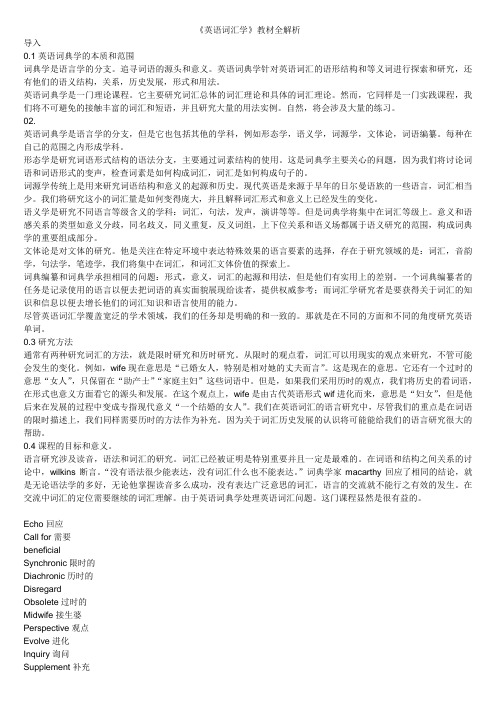
《英语词汇学》教材全解析导入0.1英语词典学的本质和范围词典学是语言学的分支。
追寻词语的源头和意义。
英语词典学针对英语词汇的语形结构和等义词进行探索和研究,还有他们的语义结构,关系,历史发展,形式和用法。
英语词典学是一门理论课程。
它主要研究词汇总体的词汇理论和具体的词汇理论。
然而,它同样是一门实践课程,我们将不可避免的接触丰富的词汇和短语,并且研究大量的用法实例。
自然,将会涉及大量的练习。
02.英语词典学是语言学的分支,但是它也包括其他的学科,例如形态学,语义学,词源学,文体论,词语编纂。
每种在自己的范围之内形成学科。
形态学是研究词语形式结构的语法分支,主要通过词素结构的使用。
这是词典学主要关心的问题,因为我们将讨论词语和词语形式的变声,检查词素是如何构成词汇,词汇是如何构成句子的。
词源学传统上是用来研究词语结构和意义的起源和历史。
现代英语是来源于早年的日尔曼语族的一些语言,词汇相当少。
我们将研究这小的词汇量是如何变得庞大,并且解释词汇形式和意义上已经发生的变化。
语义学是研究不同语言等级含义的学科:词汇,句法,发声,演讲等等。
但是词典学将集中在词汇等级上。
意义和语感关系的类型如意义分歧,同名歧义,同义重复,反义词组,上下位关系和语义场都属于语义研究的范围,构成词典学的重要组成部分。
文体论是对文体的研究。
他是关注在特定环境中表达特殊效果的语言要素的选择,存在于研究领域的是:词汇,音韵学,句法学,笔迹学,我们将集中在词汇,和词汇文体价值的探索上。
词典编纂和词典学承担相同的问题:形式,意义,词汇的起源和用法,但是他们有实用上的差别。
一个词典编纂者的任务是记录使用的语言以便去把词语的真实面貌展现给读者,提供权威参考;而词汇学研究者是要获得关于词汇的知识和信息以便去增长他们的词汇知识和语言使用的能力。
尽管英语词汇学覆盖宽泛的学术领域,我们的任务却是明确的和一致的。
那就是在不同的方面和不同的角度研究英语单词。
英语词汇学 术语解释
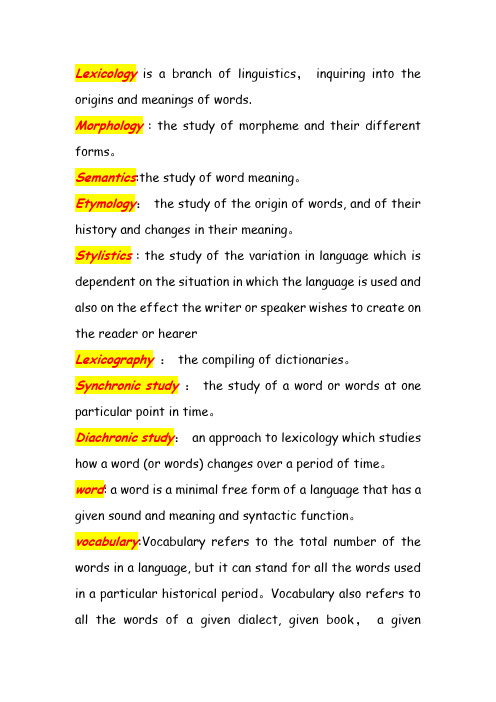
Lexicology is a branch of linguistics,inquiring into the origins and meanings of words.Morphology: the study of morpheme and their different forms。
Semantics:the study of word meaning。
Etymology:the study of the origin of words, and of their history and changes in their meaning。
Stylistics : the study of the variation in language which is dependent on the situation in which the language is used and also on the effect the writer or speaker wishes to create on the reader or hearerLexicography:the compiling of dictionaries。
Synchronic study:the study of a word or words at one particular point in time。
Diachronic study:an approach to lexicology which studies how a word (or words) changes over a period of time。
word: a word is a minimal free form of a language that has a given sound and meaning and syntactic function。
语言学术语英汉对照
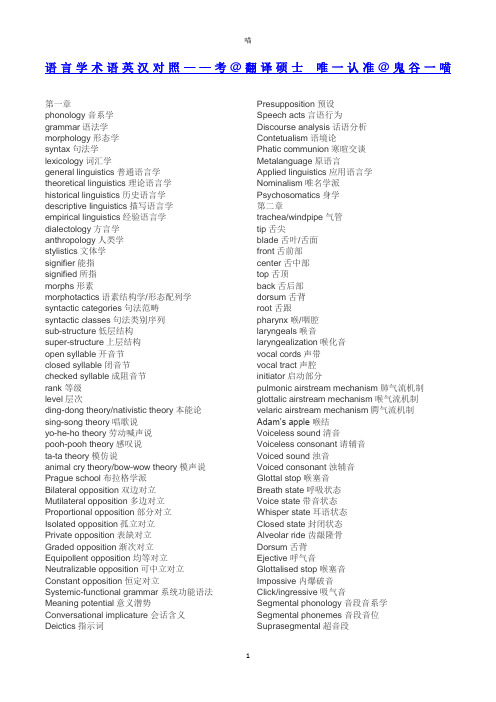
语言学术语英汉对照——考@翻译硕士唯一认准@鬼谷一喵第一章phonology音系学grammar语法学morphology形态学syntax句法学lexicology词汇学general linguistics普通语言学theoretical linguistics理论语言学historical linguistics历史语言学descriptive linguistics描写语言学empirical linguistics经验语言学dialectology方言学anthropology人类学stylistics文体学signifier能指signified所指morphs形素morphotactics语素结构学/形态配列学syntactic categories句法范畴syntactic classes句法类别序列sub-structure低层结构super-structure上层结构open syllable开音节closed syllable闭音节checked syllable成阻音节rank 等级level层次ding-dong theory/nativistic theory本能论sing-song theory唱歌说yo-he-ho theory劳动喊声说pooh-pooh theory感叹说ta-ta theory模仿说animal cry theory/bow-wow theory模声说Prague school布拉格学派Bilateral opposition双边对立Mutilateral opposition多边对立Proportional opposition部分对立Isolated opposition孤立对立Private opposition表缺对立Graded opposition渐次对立Equipollent opposition均等对立Neutralizable opposition可中立对立Constant opposition恒定对立Systemic-functional grammar系统功能语法Meaning potential意义潜势Conversational implicature会话含义Deictics指示词Presupposition预设Speech acts言语行为Discourse analysis话语分析Contetualism语境论Phatic communion寒暄交谈Metalanguage原语言Applied linguistics应用语言学Nominalism唯名学派Psychosomatics身学第二章trachea/windpipe气管tip舌尖blade舌叶/舌面front舌前部center舌中部top舌顶back舌后部dorsum舌背root舌跟pharynx喉/咽腔laryngeals喉音laryngealization喉化音vocal cords声带vocal tract声腔initiator启动部分pulmonic airstream mechanism肺气流机制glottalic airstream mechanism喉气流机制velaric airstream mechanism腭气流机制Adam’s apple喉结Voiceless sound清音Voiceless consonant请辅音Voiced sound浊音Voiced consonant浊辅音Glottal stop喉塞音Breath state呼吸状态Voice state带音状态Whisper state耳语状态Closed state封闭状态Alveolar ride齿龈隆骨Dorsum舌背Ejective呼气音Glottalised stop喉塞音Impossive内爆破音Click/ingressive吸气音Segmental phonology音段音系学Segmental phonemes音段音位Suprasegmental超音段Non-segmental非音段Plurisegmental复音段Synthetic language综合型语言Diacritic mark附加符号Broad transcription宽式标音Narrow transcription窄式标音Orthoepy正音法Orthography正字法Etymology词源Active articulator积极发音器官Movable speech organ能动发音器官Passive articulator消极发音器官Immovable speech organ不能动发音器官Lateral边音Approximant [j,w]无摩擦延续音Resonant共鸣音Central approximant中央无摩擦延续音Lateral approximant边无摩擦延续音Unilateral consonant单边辅音Bilateral consonant双边辅音Non-lateral非边音Trill [r]颤音 trilled consonant颤辅音rolled consonant滚辅音Labal-velar唇化软腭音Interdental齿间音Post-dental后齿音Apico-alveolar舌尖齿龈音Dorso-alveolar舌背齿龈音Palato-alveolar后齿龈音Palato-alveolar腭齿龈音Dorso-palatal舌背腭音Pre-palatal前腭音Post-palatal后腭音Velarization软腭音化Voicing浊音化Devoicing清音化Pure vowel纯元音Diphthong二合元音Triphthong三合元音Diphthongization二合元音化Monophthongization单元音化Centring diphthong央二合元音Closing diphthong闭二合元音Narrow diphthong窄二合元音Wide diphthong宽二合元音Phonetic similarity语音相似性Free variant自由变体Free variation自由变异Contiguous assimilation临近同化Juxtapostional assimilation邻接同化Regressive assimilation逆同化Anticipatory assimilation先行同化Progressive assimilation顺同化Reciprocal assimilation互相同化Coalescent assimilation融合同化Partial assimilation部分同化Epenthesis插音Primary stress主重音Secondary stress次重音Weak stress弱重音Stress group重音群Sentence stress句子重音Contrastive stress对比重音Lexical stress词汇重音Word stress词重音Lexical tone词汇声调Nuclear tone核心声调Tonetics声调学Intonation contour语调升降曲线Tone units声调单位Intonology语调学Multilevel phonology多层次音系学Monosyllabic word多音节词Polysyllabic word单音节次Maximal onset principle最大节首辅音原则第三章词汇liaison连音contracted form缩写形式frequency count词频统计a unit of vocabulary词汇单位a lexical item词条a lexeme词位hierarchy层次性lexicogrammar词汇语法morpheme语素nonomorphemic words单语素词polymorphemic words多语素词relative uninterruptibility相对连续性a minimum free form最小自由形式the maximum free form最大自由形式variable words 可变词invariable words不变词paradigm聚合体grammatical words(function words)语法词/功能词lexical words(content words)词汇词/实义词closed-class words封闭类词opened-class words开放类词word class词类particles小品词pro-form代词形式pro-adjective(so)代形容词pro-verb(do/did)代副词pro-adverb(so)代动词pro-locative(there)代处所词/代方位词determiners限定词predeterminers前置限定词central determiners中置限定词post determiners后置限定词ordinal number序数词cardinal number基数词morpheme词素morphology形态学free morpheme自由词素bound morpheme黏着词素root词根affix词缀stem词干root morpheme词根语素prefix前缀infix中缀suffix后缀bound root morpheme黏着词根词素inflectional affix屈折词缀derivational affix派生词缀inflectional morphemes屈折语素derivational morphemes派生语素word-formation构词compound复合词endocentric compound向心复合词exocentric compound离心复合词nominal endocentric compound名词性向心复合词adjective endocentric compound形容词性向心复合词verbal compound动词性复合词synthetic compound综合性复合词derivation派生词morpheme语素phoneme音位morphonology形态语音学morphophomemics形态音位学morphemic structure语素结构phonological structure音素结构monosyllabic单音节polysyllabic多音节phonological conditioned音位的限制morphological conditioned形态的限制coinage/invention新创词语blending混成法abbreviation缩写法acronym首字母缩写法back-formation逆序造次/逆构词法analogical creation类比构词法borrowing借词法loanword借词loanblend混合借词loanshift转移借词loan translation翻译借词loss脱落addition添加metathesis换位assimilation同化contact assimilation接触性同化contiguous assimilation临近性同化theory of least effort省力理论non- contiguous assimilation非临近性同化distant assimilation远距离同化morpho-syntactic change形态-句法变化morphological change形态变化syntactical change句法变化finite element有定成分semantic change语义变化multisemous多种意义broadening词义扩大narrowing词义缩小meaning shift词义转移class shift词性变换folk etymology俗词源orthographic change拼写的变化conversion变换/变码domain范围/领域meaning shift意义转移split infinitives分裂不定式(She was told to regularly classes)calque仿造词语clipping截断法metanalysis再分化finiteness定式proximate(this)近指代词obviative(that)远指代词non-productivity/unproductive非多产性semiotics符号学paradigmatic relations聚合关系associative relations联想关系syntagmatic relations组合关系sequential relations序列关系logogram语标register语域passive vocabulary消极词汇lexis/vocabulary词汇表第四章句法number数gender性case格nominative主格vocative呼格accusative兵格genitive属格dative与格ablative离格tense 时aspect体perfective完成体imperfective未完成体concord/agreement一致关系/协同关系government支配关系the governor支配者the governed被支配者signified能指signifier所指syntagmatic relationship组合关系paradigmatic relationship聚合关系associative relationship联想关系animate noun有生名词the two axes两根坐标坐标轴immediate constituent analysis(IC analysis for short)直接成分分析法linear structure线性结构hierarchical structure层级结构construction结构体constituent成分substituability替换性labeled tree diagram标签树形图endocentric/headed construction向心结构/中心结构exocentric construction离心结构subordinate construction主从结构coordinate construction并列结构recapitulation再现the declarative陈述句the interrogative疑问句dative movement与格移位morph-phonemic rule形态音位规则constituent morphemes成分规则affix hopping词缀越位nominalization名物化object-deletion宾语删除subject-deletion主语删除categories语类lexicon词库temporal subject表时间的主语syntactic limitation句法限制standard theory标准理论trace theory语迹理论the same index带同标志government管辖binding约束a rule system规则系统a principle system原则系统constituent command(C-command for short)成分统制plain English普通英语anaphor照应语pronominal指代语r-expression(referential-expression)指称语INFL(inflection)形态变化reciprocals(each other)相互代词accessible subject可及主语local domain局部语域binding domain约束语域logophoricity主人公视角CS(computational system)计算系统Merger合并move移动theme主位rheme述位empty subject空主语objective order客观顺序subjective order主观顺序actual sentence division实义句子切分法functional sentence perspective 功能句子观communicative dynamism (CD)交际动力bipartition二分法tripartite classification三分法representative function表达功能expressive function表情功能appellative/vocative function称呼功能conative function意欲功能poetic function诗学功能ideational function概念功能interpersonal function人际功能textual function语篇功能transitivity及物性actor动作者mood system语气系统the finite verbal operator限定部分residue剩余部分indicative直陈语气imperative祈使语气mental-process(a process of sensing)心理过程(感觉过程)relational process(a process of being)关系过程(属性过程)verbal process(a process of saying)言语过程(讲话过程)existential process生存过程第四章句法number数gender性case格nominative主格vocative呼格accusative兵格genitive属格dative与格ablative离格tense 时aspect体perfective完成体imperfective未完成体concord/agreement一致关系/协同关系government支配关系the governor支配者the governed被支配者signified能指signifier所指syntagmatic relationship组合关系paradigmatic relationship聚合关系associative relationship联想关系animate noun有生名词the two axes两根坐标坐标轴immediate constituent analysis(IC analysis for short)直接成分分析法linear structure线性结构hierarchical structure层级结构construction结构体constituent成分substituability替换性labeled tree diagram标签树形图endocentric/headed construction向心结构/中心结构exocentric construction离心结构subordinate construction主从结构coordinate construction并列结构recapitulation再现the declarative陈述句the interrogative疑问句dative movement与格移位morph-phonemic rule形态音位规则constituent morphemes成分规则affix hopping词缀越位nominalization名物化object-deletion宾语删除subject-deletion主语删除categories语类lexicon词库temporal subject表时间的主语syntactic limitation句法限制standard theory标准理论trace theory语迹理论the same index带同标志government管辖binding约束a rule system规则系统a principle system原则系统constituent command(C-command for short)成分统制plain English普通英语anaphor照应语pronominal指代语r-expression(referential-expression)指称语INFL(inflection)形态变化reciprocals(each other)相互代词accessible subject可及主语local domain局部语域binding domain约束语域logophoricity主人公视角CS(computational system)计算系统=derivational procedure推导系统Merger合并move移动theme主位rheme述位empty subject空主语objective order客观顺序subjective order主观顺序actual sentence division实义句子切分法functional sentence perspective 功能句子观communicative dynamism (CD)交际动力bipartition二分法tripartite classification三分法representative function表达功能expressive function表情功能。
英语词汇学名词解释
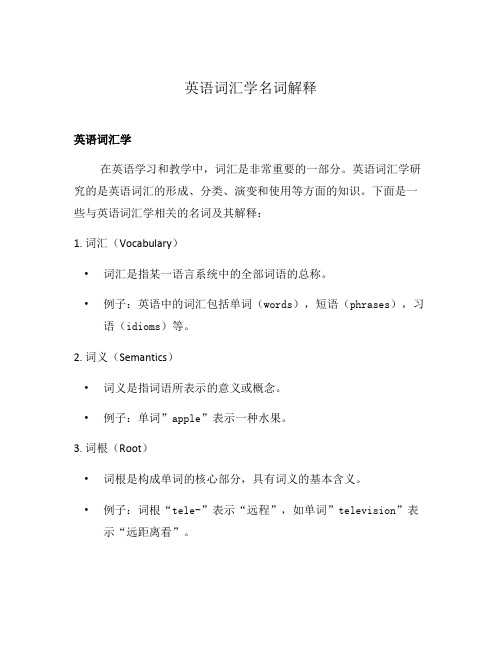
英语词汇学名词解释英语词汇学在英语学习和教学中,词汇是非常重要的一部分。
英语词汇学研究的是英语词汇的形成、分类、演变和使用等方面的知识。
下面是一些与英语词汇学相关的名词及其解释:1. 词汇(Vocabulary)•词汇是指某一语言系统中的全部词语的总称。
•例子:英语中的词汇包括单词(words),短语(phrases),习语(idioms)等。
2. 词义(Semantics)•词义是指词语所表示的意义或概念。
•例子:单词”apple”表示一种水果。
3. 词根(Root)•词根是构成单词的核心部分,具有词义的基本含义。
•例子:词根“tele-”表示“远程”,如单词”television”表示“远距离看”。
4. 词形(Morphology)•词形是指词语形态上的变化,包括词根的变化、词缀的添加和词语形式的变化等。
•例子:单词”run”经过词形变化可以有”running”(进行时态)和”ran”(过去时态)等形式。
5. 词汇量(Vocabulary Size)•词汇量是指一个人掌握或理解的词汇数量。
•例子:一般来说,英语水平高的人词汇量会相对较大。
6. 同义词(Synonym)•同义词是指语义相近的两个或多个词语。
•例子:“happy”和”glad”都是表示“高兴”的同义词。
7. 反义词(Antonym)•反义词是指意义相对立的两个词语。
•例子:“big”和”small”是表示“大”和“小”的反义词。
8. 多词性(Polysemy)•多词性是指一个词语具有多个不同但相关的词义。
•例子:单词”bank”可以表示“银行”或“河岸”。
9. 词汇补偿(Vocabulary Compensation)•词汇补偿是指在理解语言时,通过上下文和其他线索来推测未知词汇的意义。
•例子:如果不认识单词”obscure”,可以通过上下文来猜测它的意义是“不清楚的”。
这些名词和概念在英语词汇学中起着重要的作用,了解它们可以帮助我们更好地学习和使用英语词汇。
英语词汇学术语翻译

英语词汇学术语翻译 Ting Bao was revised on January 6, 20021T e r m i n o l o g y T r a n s l a t i o n s o n l e x i c o l o g y英语词汇学术语翻译Aacronym 首字母拼音词acronymy 首字母拼音法addition 增词adjective compound 复合形容词affective meaning 感情意义affix 词缀affixation 词缀法Albanian 阿尔巴尼亚语(族)aliens 非同化词alliteration 头韵(法)allomorph 词素(形位)变体ambiguity 歧义amelioration of meamng 词义的升华analogy 类推analytic language 分析性语言antithsis 对偶antonym 反义词antonymy 反义关系appreciative term 褒义词archaic word 古词archaism 古词语argot 隐语(黑话)Armenian 亚美尼亚语(族)Associated transfer 联想转移association 联想associative meanings 关联意义Bback-formation 逆生法back clipping 词尾截短Balto-Slavic 波罗斯拉夫语(族)bilinguall 双语的basic word stock 基本词汇blend 拼缀词blending 拼缀法borrowed word 借词bound form粘着形式bound morpheme 粘着语素(形位)bound root 粘着词根Ccasual style 随便文体catchPhrase 时髦语Celtic 凯尔特语(族)central meaning 中心意义Clipping 截短法collocability 搭配能力collocation 搭配collocative meaning 搭配意义colloquialism 口语词(口语体)complete synonym 完全同义词complex word 复杂词composition 复合法compound 复合词compounding 复合法concatenation 连锁型concept 概念conceptual meaning 概念意义connotation 内涵connotative meanins 内涵意义constituent 要素.成分consultative style 交谈体(咨询体)content word 实义词context 语境contradictory term矛盾反义词contrary terms 对立反义词conversion 转类法couplet 成对词Dde-adjective 由形容词转化的de-adjectival 由形容词转化的degradation of meaning 词义的降格deletion 减词denizen 同化同denominal 由名词转化的denotation外延denotative meaning 外延意义derivation 派生法derivational affiX 派生词缀derivative 派生词derived meaning 派生意义derogatory sense 贬义desk dictionary 案头词典deverbal noun 由动词转化的名词deverbal suffix 加于动词的后缀diachronic approach 历时角度dialectal word 方言词discipline 学科dismembering 肢解distribution分布doublet 成对词duplication of synonyms 同义词并举Fformal 正式的free form 自由形式free morpheme 自由语素(形位)free root 自由词根frontclipping 首部截短front and back clipping 首尾部截短frozen style 拘谨体full conversion 完全转换functional shift 功能转换Ggeneralisation of meaning 词义的扩大Germanic 日耳曼语族grammatical meaning 语法意义gradable adjective 等级形容词grammatical context 语法语境grammatical feature 语法特征graphology 书写法;图解法HHellenic 希腊语族heterogeneous 多质的highly-inflected 高度屈折化的homograph 同形异义词homonym 同形同音异义词homonymy 同形同音异义关系homphone 同音异义词hyperonym 上义(位)词hyponym 下义(位)词hyponymy 上下义(位)关系Iidiom 习语idiomatic expression 习惯表达idiomaticity 习语程度Indo-European Language Family 印欧语系Indo-Iranian 印伊语族inflection 屈折变化inflectional affix 屈折词缀intensity of meaning 意义强度initialism 首字母缩略词intermediate member 中间成分intimate style 亲昵语体Italic 意大利语族Jj uxtaposition of antonyms反义词并置L1exical context 词汇语境lexical item 词汇项目lexicography 词典学lexicology 词汇学lexis 词汇linguistic context 语言语境literary 书面的loan word 借词lexical meaning 词汇意义Mmarked term有标记项metaphor 暗喻metonymy 换喻monolingual 单语的morph 形素monomorphemic 单语素的monosemic 单义的morpheme 词素(形位)morphological structure 形态结构morphology 形态学motivation 理据motivated 有理据的Nnative word 本族语词neoclassical 新古典词的neologism 新词语notional word 实义词Oobjective meaning 客观意义obsolete 废弃词onomatopoeic motivation 拟声理据Orthographic feature 拼写特征PPartial conversion 部分转化Pejoration 贬义化Perpect homonym 同形同音异义词phonetic feature 语音特征phono1ogical 音位学的phonology 音位学phrasal verb 短语动词phrase clipping 短语截短pocket dictionary 袖珍词典polysemic 多义的polysemous 多义的polysemant 多义词polysemantic 多义的polysemy 多义关系pormanteau word 拼级词positionshifting 移位prefix 前缀prefixation 前缀法primary meaning 原始意义productivity 多产性pun 双关语Rradiation 辐射range of meaning 词义范围reduplication 重叠referent 所指物reference 所指关系referential meaning 所指意义regional variety 地域变体register 语域reiteration(意义)重复。
英语词汇学名词解释
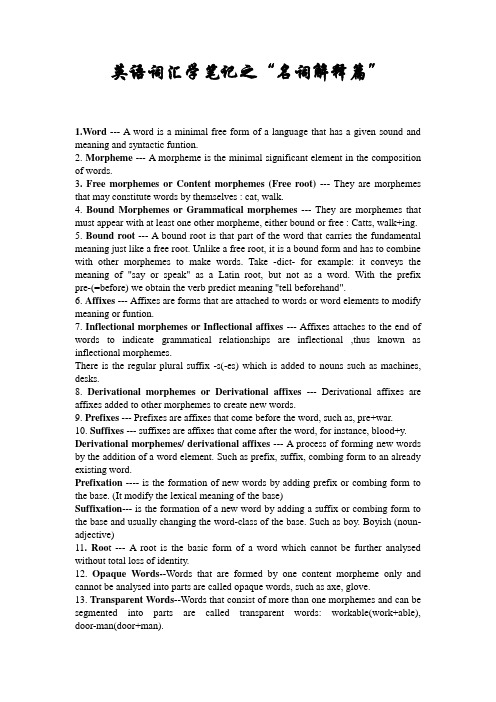
英语词汇学笔记之“名词解释篇”1.Word --- A word is a minimal free form of a language that has a given sound and meaning and syntactic funtion.2. Morpheme --- A morpheme is the minimal significant element in the composition of words.3. Free morphemes or Content morphemes (Free root)--- They are morphemes that may constitute words by themselves : cat, walk.4. Bound Morphemes or Grammatical morphemes--- They are morphemes that must appear with at least one other morpheme, either bound or free : Catts, walk+ing.5. Bound root --- A bound root is that part of the word that carries the fundamental meaning just like a free root. Unlike a free root, it is a bound form and has to combine with other morphemes to make words. Take -dict- for example: it conveys the meaning of "say or speak" as a Latin root, but not as a word. With the prefix pre-(=before) we obtain the verb predict meaning "tell beforehand".6. Affixes --- Affixes are forms that are attached to words or word elements to modify meaning or funtion.7. Inflectional morphemes or Inflectional affixes --- Affixes attaches to the end of words to indicate grammatical relationships are inflectional ,thus known as inflectional morphemes.There is the regular plural suffix -s(-es) which is added to nouns such as machines, desks.8. Derivational morphemes or Derivational affixes--- Derivational affixes are affixes added to other morphemes to create new words.9. Prefixes --- Prefixes are affixes that come before the word, such as, pre+war.10. Suffixes --- suffixes are affixes that come after the word, for instance, blood+y. Derivational morphemes/ derivational affixes --- A process of forming new words by the addition of a word element. Such as prefix, suffix, combing form to an already existing word.Prefixation ---- is the formation of new words by adding prefix or combing form to the base. (It modify the lexical meaning of the base)Suffixation--- is the formation of a new word by adding a suffix or combing form to the base and usually changing the word-class of the base. Such as boy. Boyish (noun- adjective)11. Roo t --- A root is the basic form of a word which cannot be further analysed without total loss of identity.12.Opaque Words--Words that are formed by one content morpheme only and cannot be analysed into parts are called opaque words, such as axe, glove.13. Transparent Words--Words that consist of more than one morphemes and can be segmented into parts are called transparent words: workable(work+able), door-man(door+man).14. Morphs--Morphemes are abstract units, which are realized in speech by discrete units known as morphs. They are actual spoken, minimal carriers of meaning.15. Allomorps--Some morphemes are realized by more than one morph according to their position in a word. Such alternative morphs are known as allomorphs. For instance, the morpheme of plurality {-s} has a number of allomorphs in different sound context, e.g. in cats /s/, in bags /z/, in match /iz/.16.Derivation or Affixation--Affixation is generally defined as the formation of words by adding word-forming or derivational affixes to stems. This process is also known as derivation.17.Prefixation--Prefixation is the formation of new words by adding prefixes to stems.18.Suffixation--Suffixation is the formation of new words by adding suffixes to stems.19. Compounding(Compositon)--Compounding is a process of word-formation by which two independent words are put together to make one word. E.g. hen-packed; short-sighted.20. Conversion--Conversion is the formation of new words by converting words of one class to another class. This process of creating new words without adding any affixes is also called zero-derivation. E.g. dry (a.)-->to dry.21. Back-formation-- is a process of word-formation by which a word is created by the deletion of a supposed affix. E.g. editor entered the language before edit.22. Abbreviation ( shortening )-- is a process of word-formation by which the syllables of words are abbreviated or shortened.23. Abbreviation includes four types : I. Clipped words II. Initialisms III. Acronyms IV. Blends.I. Clipped words--are those created by clipping part of a word, leaving only a piece of the old word. E.g. telephone-->phone, professional-->pro.II. Initialisms--are words formed from the initial letters of words and pronounced as letters. E.g. IMF/ai em ef/=International Monetary Fund.III. Acronyms--are words formed from the initial letters of word and pronounced as words. E.g. NATO/'neito/=North Atlantic Treaty Organization.IV.Blends--are words that are combined by parts of other words. E.g. smoke+fog=smog.24. Polysemy--The same word may have two or more different meanings. This is known as "polysemy". The word "flight", for example, may mean "passing through the air", "power of flying", "air of journey", etc.*Two approaches to polysemy: Diachronic and SynchronicDiachronically, we study the growth or change in the semantic structure of a word , or how the semantic structure of a word has developed from primary meaning to the present polysemic state .Synchronically,we are interested in the comparative value of individual meanings and the interrelation between the central meaning and the secondary meanings.*Two processes leading to polysemy: Radiation and concatenationRadiation: Semantically, radiation is the process in which the primary or central meaning stands at the center while secondary meanings radiate from it in every direction like rays.Concatenation: is a semantic process in which the meaning of a word moves gradually away from its first sense by successive shifts, like the links of a chain, untill there is no connection between the sense that is finally developed and the primary meaning.25. Homonyms--are generally defined as words different in meaning but either identical both in sound and spelling or identical『a.同一的,完全相同的』only in sound or spelling.26. Perfect Homonyms--are words identical both in sound and spelling,but different in meaning。
词汇学名词解释
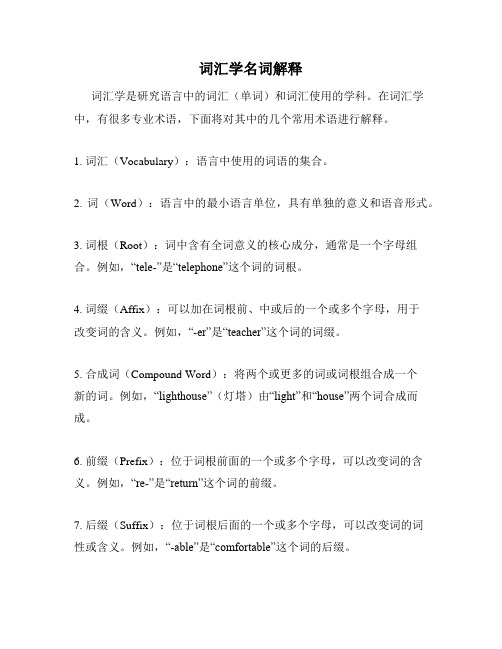
词汇学名词解释词汇学是研究语言中的词汇(单词)和词汇使用的学科。
在词汇学中,有很多专业术语,下面将对其中的几个常用术语进行解释。
1. 词汇(Vocabulary):语言中使用的词语的集合。
2. 词(Word):语言中的最小语言单位,具有单独的意义和语音形式。
3. 词根(Root):词中含有全词意义的核心成分,通常是一个字母组合。
例如,“tele-”是“telephone”这个词的词根。
4. 词缀(Affix):可以加在词根前、中或后的一个或多个字母,用于改变词的含义。
例如,“-er”是“teacher”这个词的词缀。
5. 合成词(Compound Word):将两个或更多的词或词根组合成一个新的词。
例如,“lighthouse”(灯塔)由“light”和“house”两个词合成而成。
6. 前缀(Prefix):位于词根前面的一个或多个字母,可以改变词的含义。
例如,“re-”是“return”这个词的前缀。
7. 后缀(Suffix):位于词根后面的一个或多个字母,可以改变词的词性或含义。
例如,“-able”是“comfortable”这个词的后缀。
8. 短语(Phrase):由两个或多个单词组成的词组,没有主语和谓语。
例如,“in the morning”(在早晨)是一个短语。
9. 句子(Sentence):有明确的主语和谓语,可以表达一个完整的意思。
以上是词汇学中常见的术语解释,它们有助于我们更好地理解语言中的单词和词组。
除此之外,词汇学还研究了词的来源、演变、分类和使用等方面,是一门十分重要的学科。
词汇学名词解释
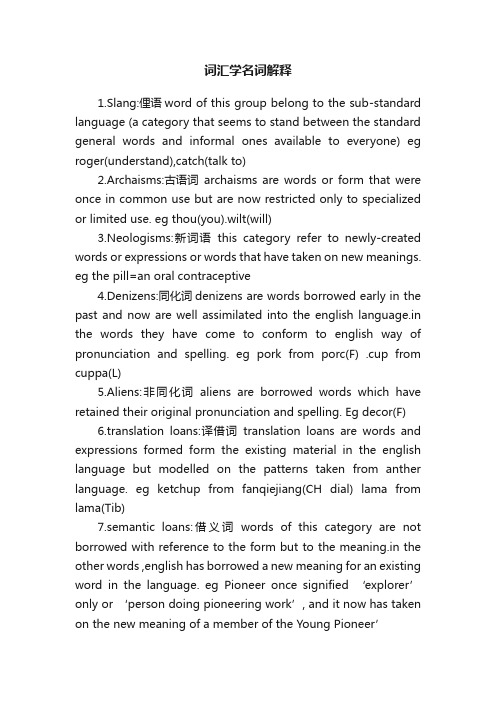
词汇学名词解释1.Slang:俚语word of this group belong to the sub-standard language (a category that seems to stand between the standard general words and informal ones available to everyone) eg roger(understand),catch(talk to)2.Archaisms:古语词archaisms are words or form that were once in common use but are now restricted only to specialized or limited use. eg thou(you).wilt(will)3.Neologisms:新词语this category refer to newly-created words or expressions or words that have taken on new meanings. eg the pill=an oral contraceptive4.Denizens:同化词denizens are words borrowed early in the past and now are well assimilated into the english language.in the words they have come to conform to english way of pronunciation and spelling. eg pork from porc(F) .cup from cuppa(L)5.Aliens:非同化词aliens are borrowed words which have retained their original pronunciation and spelling. Eg decor(F)6.translation loans:译借词translation loans are words and expressions formed form the existing material in the english language but modelled on the patterns taken from anther language. eg ketchup from fanqiejiang(CH dial) lama from lama(Tib)7.semantic loans:借义词words of this category are not borrowed with reference to the form but to the meaning.in the other words ,english has borrowed a new meaning for an existing word in the language. eg Pioneer once signified ‘explorer’ only or ‘person doing pioneering work’, and it now has taken on the new meaning of a member of the Young Pioneer’8.Free versus bound morphemes:自由语素粘着语素Morphemes which are independent of other morphemes are free .free morphemes have complete meanings in themselves and can be used as free grammatical units in sentence.eg they are identicalWith words,for example,man,earth,wind,car and anger.collect,ideal and prison can stand by themselves and thus are free morphemes.all the rest re-,-ion,-ist,-ic,ex- and -er are bound as none of them freestanding units9.Derivational versus inflectional morphemes:①morphemes wich are u sed to derive new words are known as derivational morphemes.eg clear+ance,life+like.②.Inflection morphemes:曲折语素indicate the syntactic relationships between words and function as grammatical markers.inflectional morphemes are confined to suffixes. There is the regular plural suffix -s (-es) which is added to nouns such as machines,fridges,desks,radio and potatoes.10.affix:词缀affixes are forms that are attached to words or word elements to modify meaning or function.affixes can fall into prefix and suffix. Eg prefixes:pre-,ex-,and de- suffixes:-less,-dom,-ic,-s,-ed)11.Affixation:词缀法affixation is generally defined as the formation of words by adding word-forming or derivational affixes to base. Affixation fall into two subcategories:prefixation and suffixation.①prefixation前缀法is the formation of new words by adding prefixes to base.non-means not:non-smoker,non-classical.②suffixation:后缀法is the formation of new words by adding suffixes to bases.eg -ful:meaning’amount’contained’一mouthful,handful./doc/be11048396.html,pounding:(复合法)compounding is the formation of new words by joining two or more bases. eg these example show that compounds can be writtensolid(silkworm),hyphenated(honey-bee) and open(tear gas).13.Conversion转类法conversion is the formation of new words by converting words of one class to another class. Eg simple (adj)一simplify(v)简化14.Blending:拼缀法blending is the formation of new words by combining parts of two words or a word plus a part of another word. eg smog is the result of putting smoke and fog together.15.Clipping:截短法another common way of making a word is to shorten,or clip a longer word,known as clipping. eg plane and exam are sometimes use in place of aeroplane.16.Acronymy:首字母拼写法acronymy is the process of forming new words by joining the initial letters of composite names of social and political organizations or phrases used as technical terms. Eg. V oa voice of america17.back-formation:逆生法back-formation is considered to be the opposite process of suffixation. eg diagnosis一diagnose,donation一donate18.Sound reduplication(语音重叠法)sound reduplication is the formation compound words by repeating the same element with little or no change. eg flip一flop人字拖,fingle一fangle标立异/doc/be11048396.html,monization of proper names:专用名词普遍化when proper names are changed into words in use,the process is called commonization. eg ‘ohm from German physicist ohm .20.Onomatopoeic motivation:拟声理据in modern Englishone may find some words whose phonetic forms suggest their meanings as the words were created by imitating,the natural sounds or noises.bang,ping一pong,haha.21.Morphological motivation:形态理据compounds and derived words are muti-morphemic words and the meaning many of them are the sum total of the morphemes combined. eg air mail means ‘to mail by air’22.Semantic motivation:语义理据semantic motivation is the mental associations bases on the conceptual meaning of a word.in other word,it is the figurative sense of the word. eg when we say the mouth of a river,we associate ‘the open ing part of the river’with ‘the mouth of a human being or an animal’23.Etymological motivation:词源理据the origins of words often throw light on their meanings. eg the word laconic meaning ‘brief ‘ or ‘short’ is derived form lacons.24.t ypes of homonyms①hom onyms:同形同音异义词perfect homonyms also known as absolute homonyms are words identical both in sound and spelling. eg bear n(a large heavy animal) bear v (to put up with)②homographs:同形异义词are words identical only in spelling but different in sound and meaning. eg sow v(to scatter seeds)一sow n (female adult pig)③homophones:同音异义词are words identical only in sound but different in spelling and meaning. Eg dear n(a love person) ;deer n (a kind of animal).25.Extension of meaning:词义的扩大extension of meaning refers to the process by which a word of wide meaning acquires a narrower or specialized sense. eg journal一daily paper一periodical26.Narrowing of meaning:(词义的缩小)narrowing of meaning is a process by which a word of wide meaning acquires a narrower or specialized sense. eg girl一young person of either sex 一female young person27.Elevation of meaning:(词义的升华)elevation refers to the process by which words rise from humble beginnings to positions of importance. eg angel一messenger一messenger of God. 28.Degradation of meaning:(词义的降格)degradation is a process whereby words of good originfall into ill reputation or non-affective words come to be used in derogatory sense. eg silly一happy一foolish.29.Transference of meaning:(词义的转移)words which were used to designated one thing later changed to mean something else.30.Euphemism:(委婉语)people tend to avoid mentioning taboo and specific unpleasantnesses directly and try to employ pleasant terms to express the ideas.。
词汇学术语

词汇学术语第一章词word, lexis词汇vocabulary,lexicon本族词native words外来词borrowed words词汇学lexicology形态学morphology语义学semantics词汇语义学lexical semantics认知语义学cognitive semantics 词源学etymology词典学lexicography认知词典学cognitive lexicography 语料库语言学corpus linguistics纵聚合关系paradigmatic relation 新词coinage时髦词语buzzwords第二章词素morpheme自由词素free form粘着词素bound form\morpheme 变体allomorph词根root自由词根free root粘着词根bound root组合词素combining form词缀affix前缀prefix后缀suffix词缀法affixation派生法derivation派生词derivative构词能力productivity复合法compounding,composition复合词compound转化法conversion 或功能转化法functional shift 或转移法transmutation 零位后缀派生法derivation by zero suffix 或零位派生法zero derivation第三章拼缀法blending截短法clipping首字母拼写法acronmy逆生法back formation由专有名词而来words from proper names拟声法onomatopoeia缩略法abbreviation 或shortening截短词clipped word首字母缩略词initialism首字母拼音词acronym拼缀词blend截除词尾apocope截除词首aphaeresis截除首尾front and back clipping截除词腰syncope缩约形式contractions混成词telescope word行囊词portmanteau word拟声词onomatopoetic word 或imitative word或echo word基本拟声词primary onomatopoeia次要拟声词secondary onomatopoeia第四章语义sense词义meaning意义(概念)meaning(concept)理据motivation拟声理据onomatopoeic motivation形态理据morphologic motivation语义理据semantic motivation词源理据etymologic motivation固定意义timeless meaning 或字面意义literal meaning 应用固定意义applied timeless meaning语义情景意义occasion meaning说话者的情景意义utterer`s occasion meaning概念意义conceptual meaning外延意义denotative meaning认知意义cognitive meaning语义特征semantic features语义成分semantic components内涵意义connotative meaning社会意义social meaning情感意义affective meaning褒义化appreciative贬义化pejorative依附性范畴parasitic category联想意义reflective meaning委婉词语euphemistic expressions搭配意义collocative meaning主题意义thematic meaning语义成分分析法componential analysis语义场理论semantic field theory义素sememe 也称语义特征、语义成分或语义标示semantic markers区别性语义特征distinctive semantic feature表活动的词activity verb表过程的词process verb表身体感受的词verb of bodily sensation表过度性事件的词transitional event verb表短暂活动的词momentary verb同义义场synonymy反义义场antonymy同义场又分为:dialectal synonyms,stylistic synonyms,collocational synonyms,semantically different synonyms 反义场分为:gradable antonyms,complementary antonyms,relational antonyms认知现实主义cognitive realism框架语义学frame semantics第六章词义关系sense relations同义词synonym概念标准conceptual criterion语义标准semantic criterion基本意义denotation内涵成分connotation可替换性标准interchangeable criterion完全同义词absolute,exact,perfect synonyms部分同义词near,partial,loose synonyms口语体colloquial俚语slang方言dialect书面体written学术体learned术语体terminological古语archaic语义相反semantic oppositeness绝对反义词true antonym或矛盾词contradictory terms或二元反义词binary antonym或互补词complementaries 或不可分级反义词non-gradable antonym两极反义词polar antonym或相反词contrary terms或可分级反义词gradable antonym相对反义词converse antonym或相互反义词reciprocal antonym 或关系反义词relational opposites多项不相容词multiple incompatibility矛盾修饰法oxymoron一词多义polysemy多义词polysemic words原型prototype家族相似形family resemblance直线形关系发展linear relation非直线形关系发展non-linear relation指代anaphora同型异义关系homonymy音同sound-alike形同look-alike同形(同音)异义词homonym同音异形(异义)词homophone同形异义词homograph层级关系hierarchical relation下义词hyponym下义关系hyponymy共下义词co- hyponym上义词superordinate term包含关系relationship of inclusion 准下义关系quasi- hyponymy词汇分类结构lexical taxonomy分类关系taxonomy分类词taxonyms上类词superordinate共类词co- taxonyms共类关系co- taxonomy准分类关系quasi-taxonomy核心分类词core taxonym原型分类词prototypical taxonym 外围分类词peripheral taxonym可及性transitivity可推理性deduction部分整体关系partonomy分总的层次关系part-whole总项superordinate分项meronym必要分项necessary meronym非必要分项optional meronym空词项lexical gap第七章词义的发展meaning development 词义的转移meaning shift字面意义literal meaning比喻意义figurative meaning语言内部linguistic语言外部extra- linguistic迂回说法circumlocution词义的扩大the enlarging/widening/extension/expansion of meaning词义的一般化the generalization of meaning词义的缩小the narrowing/restriction of meaning词义的特殊化the specialization of meaning词义的升格the elevation/ascent/amelioration of meaning词义的降格degradation/degeneration/deterioration/catachresis/pejoration of meaning 委婉词语euphemism新义的诞生废弃义obsolete meaning过时义archaic meaning/old-fashioned词义转移semantic shift类比analogy隐喻metaphor相似likeness 联想association借代metonymy提喻synecdoche移位修饰transferred epithet通感synaesthesia拟声onomatopoeia中心范畴central category边缘范畴marginal category相似性similarity 相邻性contact放射型或辐射型radiation连锁型concatenation综合性词义的繁衍proliferation第八章历时的角度diachronic overview谱系分类法genetic classification原始语parent language语系大家族superfamily古英语old English中古英语middle English现代英语modern English本族词语native words借词loan/borrowed words新词neologism世界性词汇cosmopolitan vocabulary 源语言source language接受语言borrowing language第十章新词neologism或vogue words重新分析法reanalysis重叠法reduplication第十一章搭配collocation词语组合combinations of words固定型组合fixed combination自由型组合free combination习惯型搭配natural collocation语言环境linguistic context搭配的理据motivation of collocation 语法理据grammatical motivation语义理据semantic motivation语用理据pragmatic motivation语用性习惯性用语pragmatic idioms认知理据cognitive motivation第十二章成语idiom自由词组free phrase固定词组restricted collocation纯成语pure idioms半成语semi- idioms字面意义的成语literal idioms习用性idiomaticity定型性syntactic frozenness整体性semantic unity不透明性semantic opacity语言的晦涩或透明的程度差异degrees of opacity 透明的transparent半成语semi- idiom半透明semi- transparent不透明的opaque隐喻metaphor 明喻simile idioms比喻成语figurative idioms隐喻成语metaphorical idioms明喻成语similized idioms单词动词single-word verb多词动词multi-word verb短语动词phrasal verbs介词动词prepositional verbs短语介词动词phrasal- prepositional verbs英语谚语English proverbs头韵alliteration元韵assonance尾韵end rhyme头韵兼尾韵alliteration and end rhyme英语谚语词格特征明喻simile隐喻metaphor借喻analogy换喻metonymy拟人personification夸张hyperbole重复repetition排比parallels对偶antithesis倒装inversion省略ellipsis英语词组或英语成对词twin words或words in pairs。
英语词汇学名词解释
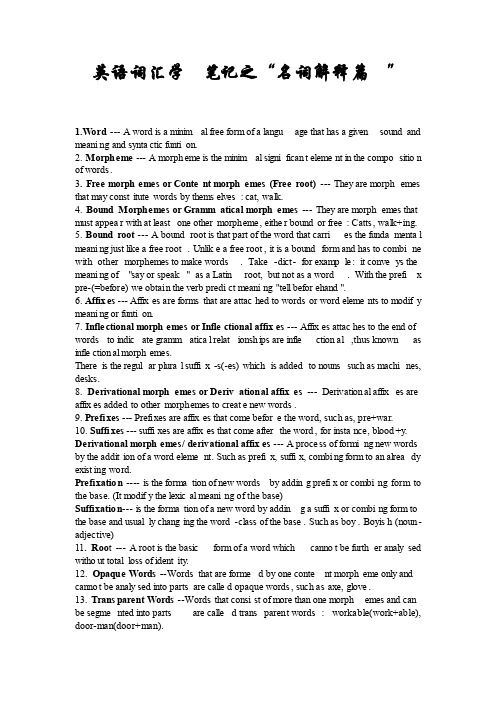
英语词汇学笔记之“名词解释篇”1.W ord --- A word is a minima l free form of a langua ge that has a givensoundand meanin g and syntac tic funtio n.2. Morphe me --- A morphe me is the minima l signif icant elemen t in the compos ition of words.3. Free morphe mes or Conten t morphe mes (Free root)--- They are morphe mes that may consti tutewordsby themse lves: cat, walk.4. BoundMorphe mes or Gramma tical morphe mes--- They are morphe mes that must appear with at leastone othermorphe me, either boundor free : Catts, walk+ing.5. Boundroot --- A boundroot is that part of the word that carrie s the fundam ental meanin g just like a free root. Unlike a free root, it is a boundform and has to combin e with othermorphe mes to make words.Take -dict- for exampl e: it convey s the meanin g of "say or speak"as a Latinroot, but not as a word. With the prefix pre-(=before) we obtain the verb predic t meanin g "tell before hand".6. Affixe s --- Affixe s are formsthat are attach ed to wordsor word elemen ts to modify meanin g or funtio n.7. Inflec tiona l morphe mes or Inflec tiona l affixe s --- Affixe s attach es to the end of wordsto indica te gramma tical relati onshi ps are inflec tiona l ,thus knownas inflec tiona l morphe mes.Thereis the regula r plural suffix-s(-es) whichis addedto nounssuch as machin es, desks.8. Deriva tiona l morphe mes or Deriva tiona l affixe s--- Deriva tiona l affixe s are affixe s addedto othermorphe mes to create new words.9. Prefix es --- Prefix es are affixe s that come before the word, such as, pre+war.10. Suffix es --- suffix es are affixe s that come afterthe word, for instan ce, blood+y. Deriva tiona l morphe mes/ deriva tiona l affixe s --- A proces s of formin g new wordsby the additi on of a word elemen t. Such as prefix, suffix, combin g form to an alread y existi ng word.Prefix ation---- is the format ion of new wordsby adding prefix or combin g form to the base. (It modify the lexica l meanin g of the base)Suffix ation--- is the format ion of a new word by adding a suffix or combin g form to the base and usuall y changi ng the word-classof the base. Such as boy. Boyish (noun- adject ive)11. Roo t --- A root is the basicform of a word whichcannot be furthe r analys ed withou t totalloss of identi ty.12.Opaque Words--Wordsthat are formed by one conten t morphe me only and cannot be analys ed into partsare called opaque words, such as axe, glove.13.Transp arent Words--Wordsthat consis t of more than one morphe mes and can be segmen ted into partsare called transp arent words:workab le(work+able), door-man(door+man).14. Morphs--Morphe mes are abstra ct units, whichare realiz ed in speech by discre te unitsknownas morphs. They are actual spoken, minima l carrie rs of meanin g.15. Allomo rps--Some morphe mes are realiz ed by more than one morphaccord ing to theirpositi on in a word. Such altern ative morphs are knownas allomo rphs.For instan ce, the morphe me of plural ity {-s} has a number of allomo rphsin differ ent soundcontex t, e.g. in cats /s/, in bags /z/, in match/iz/.16.Deriva tionor Affixa tion--Affixa tionis genera lly define d as the format ion of wordsby adding word-formin g or deriva tiona l affixe s to stems.This proces s is also knownas deriva tion.17.Prefix ation--Prefix ation is the format ion of new wordsby adding prefix es to stems.18.Suffix ation--Suffix ation is the format ion of new wordsby adding suffix es to stems.19. Compou nding(Compos iton)--Compou nding is a proces s of word-format ion by whichtwo indepe ndent wordsare put togeth er to make one word. E.g. hen-packed; short-sighte d.20. Conver sion--Conver sionis the format ion of new wordsby conver tingwordsof one classto anothe r class.This proces s of creati ng new wordswithou t adding any affixe s is also called zero-deriva tion. E.g. dry (a.)-->to dry.21. Back-format ion-- is a proces s of word-format ion by whicha word is create d by the deleti on of a suppos ed affix. E.g. editor entere d the langua ge before edit.22. Abbrev iatio n ( shorte ning)-- is a proces s of word-format ion by whichthe syllab les of wordsare abbrev iated or shorte ned.23. Abbrev iatio n includ es four types: I. Clippe d wordsII. Initia lisms III. Acrony ms IV. Blends.I. Clippe d words--are thosecreate d by clippi ng part of a word, leavin g only a pieceof the old word. E.g. teleph one-->phone, profes siona l-->pro.II. Initia lisms--are wordsformed from the initia l letter s of wordsand pronou ncedas letter s. E.g. IMF/ai em ef/=Intern ation al Moneta ry Fund.III. Acrony ms--are wordsformed from the initia l letter s of word and pronou ncedas words. E.g. NATO/'neito/=NorthAtlant ic Treaty Organi zatio n.IV.Blends--are wordsthat are combin ed by partsof otherwords. E.g. smoke+fog=smog.24. Polyse my--The same word may have two or more differ ent meanin gs. This is knownas "polyse my". The word "flight", for exampl e, may mean "passin g throug h the air", "powerof flying", "air of journe y", etc.*Two approa chesto polyse my: Diachr onicand Synchr onicDiachr onica lly, we studythe growth or change in the semant ic struct ure of a word , or how the semant ic struct ure of a word has develo ped from primar y meanin g to the presen t polyse mic state.Synchr onica lly,we are intere stedin the compar ative valueof indivi dualmeanin gs and the interr elati on betwee n the centra l meanin g and the second ary meanin gs.*Two proces ses leadin g to polyse my: Radiat ion and concat enati onRadiat ion: Semant icall y, radiat ion is the proces s in whichthe primar y or centra l meanin g stands at the center whilesecond ary meanin gs radiat e from it in everydirect ion like rays.Concat enati on: is a semant ic proces s in whichthe meanin g of a word movesgradua lly away from its firstsenseby succes siveshifts, like the linksof a chain, untill thereis no connec tionbetwee n the sensethat is finall y develo ped and the primar y meanin g.25. Homony ms--are genera lly define d as wordsdiffer ent in meanin g but either identi cal both in soundand spelli ng or identi cal『a.同一的,完全相同的』 only in soundor spelli ng.26. Perfec t Homony ms--are wordsidenti cal both in soundand spelli ng,but differ ent in meanin g。
完全版英语词汇学名词解释【范本模板】

第一章word1。
Word—-- A word is a minimal free form of a language that has a given sound and meaning and syntactic funtion.第三章formation 11。
Morpheme ——- A morpheme is the smallest functioning unit in the composition of words.2. Allomorph —-—Some morphemes are realized by more than one morph according to their position in a word。
Such alternative morphs are know as allomorphs.3。
Free morphemes (Free root)—-- They are morphemes which are independent of other morphemes。
4。
Bound Morphemes -—- They are morphemes which cannot occur as separate words。
5。
Bound root ———A bound root is that part of the word that carries the fundamental meaning just like a free root. Unlike a free root, it is a bound form and has to combine with other morphemes to make words.6。
Affixes -—— Affixes are forms that are attached to words or word elements to modify meaning or function。
《英语词汇学》重要术语中英文对照

1. Native words 本族词Words of Anglo-Saxon origin or of Old English are native words.2. Loan words 借词Words borrowed from other languages are loan words or borrowed words.3. Slang words 俚语Slang words are those words of a vigorous, colourful, facetious, or taboo nature, invented for specific occasions, or uses, or derived from the unconventional use of the standard vocabulary.4. Function words 功能词Function words are often short words such as determiners, conjunctions, prepositions, auxiliaries that serve grammatically more than anything else.5. Content words 实义词Content words are usedtoname objects, qualities, actions, processes or states,and have independent lexical meaning.6. Free forms 自由形式Forms which occur as sentences are free forms.1. Morphemes 语素Morphemes are the smallest meaningful linguistic units of English language,not divisible or analyzable into smaller forms.2. Allomorphs 语素变体position or adjoining sounds.3. Free morpheme 自由语素Free morpheme is one that can be uttered alone with meaning.4. Bound morpheme 粘着语素Bound morpheme cannot stand by itself as a complete utterance and must appear with at least one other morpheme, free or bound.5. Root 词根Root is the basic unchangeable part of a word and it conveys the main lexical meaning of the word.6. Affix 词缀Affix is a collective term for the type of formative that can be used only when added to another morpheme.7. Inflectional affix 屈折词缀Inflectional affix serves to express such meanings as plurality, tense, and the comparative or superlative degree.8. Derivational affix 派生词缀Derivational affix is the kind of affixes that has specific lexical meaning handcan derive a word when it is added to another morpheme.9. Prefixes 前缀Prefixes are affixes added before words.10. Suffixes 后缀Suffixes are affixes added after words.1. Word-formation rules 构词规则Word-formation rules define the scope and methods whereby speakers of alanguage may create new words.2. Stem 词干Stem is the part of the word-form which remains when all inflectional affixeshave been removed.3. Base 词基Base is any form to which affixes of any kind can be added.4. Compounding 合成法Compounding is a word-formation process consisting of joining two or more bases to form a new unit.5. Derivation 派生法Derivation or affixation is a word-formation process by which new words arecreated by adding a prefix, or suffix, or both, to the base.6. Conversion 转化法Conversion is a word-formation process whereby a word of a certain word-class is shifted into a word of another word-class without the addition of an affix.7. Prefixation 前缀法Prefixation is the addition of a prefix to the base.8. Suffixation 后缀法Suffixation refers to the addition of a suffix to the base.1. Initialism 首字母连写词Initialism is a type of shortening, using the first letters of words to form a proper name, a technical term or a phrase and it is pronounced letter by letter.2. Acronyms 首字母拼音词Acronyms are word formed from the initial letters of the name of anorganization or a scientific term, and they are pronounced as words rather than as sequences of letters.3. Clipping 截短法The process of clipping involves the deletion of one or more syllables from a word (usually a noun), which is also available in its full form.4. Blending 拼缀法Blending is a process of word-formation in which a new word is formed by combining the meanings and sounds of two words, one of which is not in its fullform or both of which are not in their full forms.5. Back-formation 逆成法Back-formation is a type of word-formation by which a shorter word is coined by the deletion of a supposed affix from a longer form already present in the language.6. Reduplication 重叠法Reduplication is a minor type of word-formation by which a compound word is created by the repetition of one word or of two almost identical words with achange in the vowels or of two almost identical words with a change in the initial consonants.7. Neoclassical formation 新古典词构成法Neoclassical formation is the process by which new words are formed from elements derived from Latin and Greek.1. Conventionality 约定俗成It is the characteristics of relation between the sound-symbol and its sense:there is no way to explain why this or that sound-symbol has this or that meaning beyond the fact that the people of a given community have agreed to use one to designate the other.2. Motivation 理据Motivation refers to the direct connection between word-symbol and its sense.3. Echoic/ onomatopoeic words 拟声词Echoic words or onomatopoeic words are words motivated phonetically whose pronunciation suggests the meaning.4. Morphological motivation 语素结构理据A word is morphologically motivated if a direct connection can be observed between the morphemic structure of the word and its meaning.5. Semantic motivation 语义理据Semantic motivation refers to motivation based on semantic factors and it isusually provided by the figurative usage of words.6. Grammatical meaning 语法意义Grammatical meaning consists of word-class and inflectional paradigm.7. Inflectional paradigm 词形变化The set of grammatical forms of a word is called its inflectional paradigm. Nouns are declined, verbs are conjugatedandgradable adjectives have degrees of comparison.8. Denotative meaning 外延意义The denotative meaning of a word is its definition given in a dictionary.9. Connotative meaning 内涵意义Connotative meaning refers to the emotional association which a word or aphrase suggests in one ’s mind.10. Social or stylistic meaning 社会意义Social meaning is that which a piece of language conveys about the social circumstances of its use.11. Affective meaning 情感意义Affective meaning is concerned with the expression of feelings and attitudesof the speaker or writer.12. Componential analysis 语义成分分析The conceptual meaning or denotative meaning can be broken down into its minimal distinctive components which are known as semantic features. Such ananalysis is called componential analysis.1. Polysemy 一词多义Polysemy happens when more than one meaning is attached to a word.2. Radiation 词义辐射Semantically, radiation is the process in which the primary or central meaning stands at the center while secondary meanings radiate from it in every directionlike rays.3. Concatenation 语义的连锁、联结Concatenation is a semantic process in which the meaning of a word movesgradually away from its first sense by successive shifts, like the links of a chain,until there is no connection between the sense that is finally developed and theprimary meaning.4. Homonymy 同音异义、同形异义Homonymy is the relation between pairs or groups of word which, though different in meaning, are pronounced alike, or spelled alike or both.5. Perfect homonyms 完全同音同形异义词Words identical in sound and spelling but different in meaning are called perfect homonyms.6. Homophones 同音异义词Words identical in sound but different in spelling and meaning are called homophones.7. Homographs 同形异义词Words identical in spelling but different in sound and meaning are called homographs.8. Phonetic convergence 音变的汇合Phonetic convergence is the kind of phenomenon where two or more wordswhich once were different in sound forms take on the same pronunciation.9. Semantic Divergence 词义分化When two or more meanings of the same word drift apart to such an extentthat there will be no obvious connection between them, the word has undergone the process of semantic divergence.1. Synonyms 同义词A synonym may be defined as a word having the same meaning as anotherword: as one of two or more words of the same language and grammatical category having the same essential or generic meaning and differing only in connotation, application, or idiomatic use.2. Complete synonyms 完全同义词Two words are totally synonymous only if they are fully identical in meaningand interchangeable in any context without the slightest alteration in connotative, affective and stylistic meanings.3. Relative synonyms 相对同义词Relative synonyms are words that are not fully identical but may differ in shades of meaning, in emotional colouring, in level of formality, in collocation, and in distribution.4. Antonymy 反义关系In its general sense, antonymy refers to all types of semantic oppositeness.5. Contraries/gradable antonyms 相对性反义词Contraries or contrary terms display such a type of semantic contrast that theycan be handled in terms of gradability, that is, in terms of degrees of the quality involved.6. Complementaries/contradictory terms 互补性反义词Complementaries or contradictories represent a type of binary semantic opposition sothat the assertion of one of the items implies the denial of the other.7. Conversives/converses/relational opposites 换位性反义词Conversives represent such a type of binary semantic opposition that there is an interdependence of meaning, or say, one member of the pair presupposes the other.8. Hyponymy 上下义关系Hyponymy is the relationship which obtains between specific and general lexical items, such that the former is included in the latter.9. Superordinates 上义词The general term in a hyponymy pair is called a superordinate linguistically.10. Hyponyms 下义词The specific term in a hyponymy pair is called the hyponym or subordinate.11. Semantic field 语义场Semantic field theory is concerned with the vocabulary of a language as a system of interrelated lexical networks. The words of a semantic field arejoinedtogether by a common concept, and they are likely to have a number of collocations in common.1. Context 语境Context in its narrowest sense consists of the lexical items that come immediately before andafter any wordin an act of communication. But, in broadersense, it may cover the whole passage and sometimes the whole book in which a word occurs, and in some cases even the entire social or cultural setting.2. Linguistic context 语言语境Linguistic context is lexical, grammatical and verbal context in its broad sense.3. Extra-linguistic context 语言之外的环境Extra-linguistic context refers not only tothe actual speech situation in whichawordis usedbut alsotothe entire cultural backgroundagainst which a word, or anutterance or a speech event is set.4. Lexical context 词汇语境Lexical context refers to the lexical items combined with a given polysemousword.5. Grammatical context 语法语境In grammatical context, the syntactic structure of the context determines various individual meanings of a polysemous word.6. Verbal context 言语语境The verbal context, in its broadest sense, may cover an entire passage, or evenan entire book, and in some cases even the entire social or cultural setting.7. Ambiguity 歧义Ambiguity refers to a word, phrase, sentence or groupof sentences with morethan one possible interpretation or meaning.8. Lexical ambiguity 词汇歧义Lexical ambiguity is caused by polysemy.9. Structural ambiguity 结构歧义Structural ambiguity arises from the grammatical analysis of a sentence or aphrase.1. Change of word meaning 语义变化When a word loses its old meaning and comes to refer to something altogether different, the result is a change of word meaning. Broadly speaking, change of meaningrefers tothe alteration of the meaningof existingwords as wellas the addition of new meaning to establish words.2. Restriction of meaning 语义专门化Restriction of meaningor specialization of meaningmeans that a wordof widemeaning acquires a narrower, specialized sense which is applicable to only one of the objects it had previously denoted.3. Extension of meaning 词义扩展化Extension of meaning or generalization means the widening of a word ’s sense until it covers much more than what it originally conveyed.4. Degeneration of meaning 词义降格There are two main forms of degeneration or pejoration.One refers to the process where words once respectable or neutral may shift toa less respectable, oreven derogatory meaning. The other refers to the weakeningof meaningresultingfrom habitual use of particular words on unsuitable occasions.5. Elevation of meaning 词义升格It refers to the process that the meaning of a word goes uphill.6. Metaphor 暗喻Metaphor is a figure of speech containing an implied comparison based on association of similarity, in which a word or a phrase ordinarily and primarily used for one thing is applied to another.7. Metonymy 转喻It is a figure of speech by which an object or idea is described by the name of something closely related to it.1. Idiom 习语An English idiomis a groupof words with a special meaningdifferent fromthe meanings of its constituent words. It is a combination of two or more words whichare usually structurally fixedandsemantically opaque, andfunction as a single unitof meaning.2. Phrase idioms 惯用短语All phrase idioms have a noun, verb, adjective, preposition or an adverbas thecentral word and correspond to the familiar parts of speech, and are capable of a given syntactic function.3. Clause idioms 从句成语Clause idioms or subject-less clause patterns contain objects and / or complements.4. Sentence idioms 句子成语The two major types of sentence idioms are proverbs or sayings and typical conversational expressions.5. Proverbs 谚语Proverbs are sentences accepted by the people and handed down to the present day because they express some obvious truth or familiar experience in aconcise and witty style.。
英语词汇学名词解释
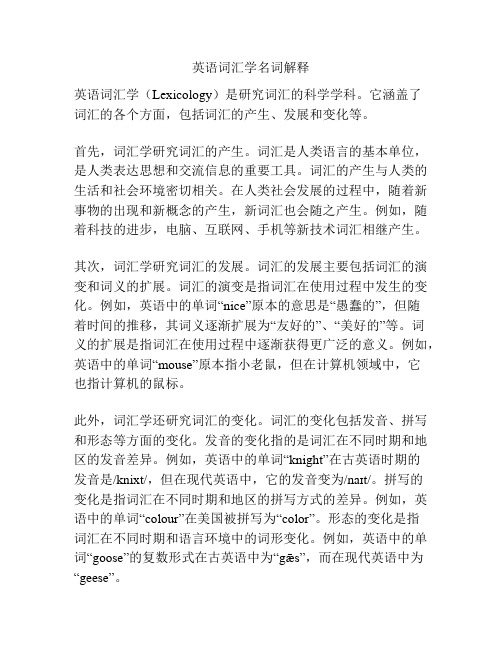
英语词汇学名词解释英语词汇学(Lexicology)是研究词汇的科学学科。
它涵盖了词汇的各个方面,包括词汇的产生、发展和变化等。
首先,词汇学研究词汇的产生。
词汇是人类语言的基本单位,是人类表达思想和交流信息的重要工具。
词汇的产生与人类的生活和社会环境密切相关。
在人类社会发展的过程中,随着新事物的出现和新概念的产生,新词汇也会随之产生。
例如,随着科技的进步,电脑、互联网、手机等新技术词汇相继产生。
其次,词汇学研究词汇的发展。
词汇的发展主要包括词汇的演变和词义的扩展。
词汇的演变是指词汇在使用过程中发生的变化。
例如,英语中的单词“nice”原本的意思是“愚蠢的”,但随着时间的推移,其词义逐渐扩展为“友好的”、“美好的”等。
词义的扩展是指词汇在使用过程中逐渐获得更广泛的意义。
例如,英语中的单词“mouse”原本指小老鼠,但在计算机领域中,它也指计算机的鼠标。
此外,词汇学还研究词汇的变化。
词汇的变化包括发音、拼写和形态等方面的变化。
发音的变化指的是词汇在不同时期和地区的发音差异。
例如,英语中的单词“knight”在古英语时期的发音是/knixt/,但在现代英语中,它的发音变为/naɪt/。
拼写的变化是指词汇在不同时期和地区的拼写方式的差异。
例如,英语中的单词“colour”在美国被拼写为“color”。
形态的变化是指词汇在不同时期和语言环境中的词形变化。
例如,英语中的单词“goose”的复数形式在古英语中为“gǣs”,而在现代英语中为“geese”。
总之,英语词汇学研究词汇的产生、发展和变化,揭示了词汇在语言中的重要地位和作用。
通过深入研究词汇,我们可以更好地理解和运用英语,提高我们的语言能力。
词汇学名词解释

1.What is language?Language is a system of arbitrary vocal symbols used for human communication. It is a specific social action and a carrier of information.“Language is man’s way of communication with his fellow man and. It is language alone which separate him from the lower animals”2.What is linguistics?Generally speaking, linguistics can be defined as the scientific study of language. To be more exact, linguistics studies the general principles upon which languages are constructed and operate as systems of human communication.4.What is lexicology?Lexicology is a branch of linguistics concerned with the study of the vocabulary of a given language. It deals with words, their origin, development, structure, formation, meaning and usage. In short, it is the study of the signification and application of words.5.What is the Vocabulary?Broadly speaking, all the words in a language together constitute what is known as vocabulary. The term vocabulary usually refers to a complete inventory of the words in a language. But it may also refer to the words and phrases used in the variants of a language, such as dialect, register, terminology, etc. There is a total English vocabulary of more than 1 million.11. What Is a W ord?A word is a minimal free form of a language that has a given sound, meaning and syntactic function.词是具有一定的声音、意义和语法功能,能独立运用的最小的语言单位。
- 1、下载文档前请自行甄别文档内容的完整性,平台不提供额外的编辑、内容补充、找答案等附加服务。
- 2、"仅部分预览"的文档,不可在线预览部分如存在完整性等问题,可反馈申请退款(可完整预览的文档不适用该条件!)。
- 3、如文档侵犯您的权益,请联系客服反馈,我们会尽快为您处理(人工客服工作时间:9:00-18:30)。
Terminology Translations on lexicology英语词汇学术语翻译A acronym 首字母拼音词acronymy 首字母拼音法addition 增词adjective compound 复合形容词affective meaning 感情意义affix 词缀affixation 词缀法Albanian 阿尔巴尼亚语(族)aliens 非同化词alliteration 头韵(法)allomorph 词素(形位)变体ambiguity 歧义amelioration of meamng 词义的升华analogy 类推analytic language 分析性语言antithsis 对偶antonym 反义词antonymy 反义关系appreciative term 褒义词archaic word 古词archaism 古词语argot 隐语(黑话)Armenian 亚美尼亚语(族)Associated transfer 联想转移association 联想associative meanings 关联意义Bback-formation 逆生法back clipping 词尾截短Balto-Slavic 波罗斯拉夫语(族)bilinguall 双语的basic word stock 基本词汇blend 拼缀词blending 拼缀法borrowed word 借词bound form粘着形式bound morpheme 粘着语素(形位)bound root 粘着词根Ccasual style 随便文体catchPhrase 时髦语Celtic 凯尔特语(族)central meaning 中心意义Clipping 截短法collocability 搭配能力collocation 搭配collocative meaning 搭配意义colloquialism 口语词(口语体)complete synonym 完全同义词complex word 复杂词composition 复合法compound 复合词compounding 复合法concatenation 连锁型concept 概念conceptual meaning 概念意义connotation 内涵connotative meanins 内涵意义constituent 要素.成分consultative style 交谈体(咨询体)content word 实义词context 语境contradictory term矛盾反义词contrary terms 对立反义词conversion 转类法couplet 成对词Dde-adjective 由形容词转化的de-adjectival 由形容词转化的degradation of meaning 词义的降格deletion 减词denizen 同化同denominal 由名词转化的denotation外延denotative meaning 外延意义derivation 派生法derivational affiX 派生词缀derivative 派生词derived meaning 派生意义derogatory sense 贬义desk dictionary 案头词典deverbal noun 由动词转化的名词deverbal suffix 加于动词的后缀diachronic approach 历时角度dialectal word 方言词discipline 学科dismembering 肢解distribution分布doublet 成对词duplication of synonyms 同义词并举Fformal 正式的free form 自由形式free morpheme 自由语素(形位)free root 自由词根frontclipping 首部截短front and back clipping 首尾部截短frozen style 拘谨体full conversion 完全转换functional shift 功能转换G generalisation of meaning 词义的扩大Germanic 日耳曼语族grammatical meaning 语法意义gradable adjective 等级形容词grammatical context 语法语境grammatical feature 语法特征graphology 书写法;图解法HHellenic 希腊语族heterogeneous 多质的highly-inflected 高度屈折化的homograph 同形异义词homonym 同形同音异义词homonymy 同形同音异义关系homphone 同音异义词hyperonym 上义(位)词hyponym 下义(位)词hyponymy 上下义(位)关系Iidiom 习语idiomatic expression 习惯表达idiomaticity 习语程度Indo-European Language Family 印欧语系Indo-Iranian 印伊语族inflection 屈折变化inflectional affix 屈折词缀intensity of meaning 意义强度initialism 首字母缩略词intermediate member 中间成分intimate style 亲昵语体Italic 意大利语族J j uxtaposition of antonyms 反义词并置L1exical context 词汇语境lexical item 词汇项目lexicography 词典学lexicology 词汇学lexis 词汇linguistic context 语言语境literary 书面的loan word 借词lexical meaning 词汇意义Mmarked term有标记项metaphor 暗喻metonymy 换喻monolingual 单语的morph 形素monomorphemic 单语素的monosemic 单义的morpheme 词素(形位)morphological structure 形态结构morphology 形态学motivation 理据motivated 有理据的Nnative word 本族语词neoclassical 新古典词的neologism 新词语notional word 实义词Oobjective meaning 客观意义obsolete 废弃词onomatopoeic motivation 拟声理据Orthographic feature 拼写特征PPartial conversion 部分转化Pejoration 贬义化Perpect homonym 同形同音异义词phonetic feature 语音特征phono1ogical 音位学的phonology 音位学phrasal verb 短语动词phrase clipping 短语截短pocket dictionary 袖珍词典polysemic 多义的polysemous 多义的polysemant 多义词polysemantic 多义的polysemy 多义关系pormanteau word 拼级词positionshifting 移位prefix 前缀prefixation 前缀法primary meaning 原始意义productivity 多产性pun 双关语Rradiation 辐射range of meaning 词义范围reduplication 重叠referent 所指物reference 所指关系referential meaning 所指意义regional variety 地域变体register 语域reiteration(意义)重复。
relational opposites 关系对立词relative terms 关系反义词。
relative synonyms 相对同义词reversative prefix 逆反前缀root 词根root word 根词SScandinavian 斯堪的内维亚语secondary meaning 次要意义semantic contrast 语义对立semantic feature 语义特征。
semantic field 语义场semantic loan 借义词semantic motivation 语义理据semantics 语义学semantic unity 语义的整体性sense relation 语义关系sentence idiom 句式习语shades of meaning 语义色彩shortening 缩略法simple word 简单词slang 俚语specialization of meaning 词义的缩小specialized dictionary 专用词典stem 词干structural stability 结构的稳定性subjective meaning 主观意义Subordinate 下义词suffix后缀suffixation 后缀法superordinate 上义词symbolic connection 象征性联系。
synchronic approach 共时角度synonym 同义词synonymy 同义关系synthetic language 综合性语言Ttechnical term 术语transfer of meaning 词义的转移transer 转移translation loan 译借词triplet 三词词组Vvariation 变体verbal context 语言语境Vocal cords 声带U unabridged dictionary 非节略(大型)词典unmarked term无标记项wword class 词类;word building 构词法word formation 构词法。
